Plants
Mt Takao is located at the borderline of warm-temperature zone and cool-temperature zone and various plants from both zones grow. There are a lot of naturally grown plants and their visitors can enjoy seasonal flowers. Over 1,500 kinds of plants are confirmed which is relevant to the number of kinds naturally grow in England. Also, over 60 kinds of plants are first found in Mt. Takao such as Takao Sumire (V. yezoensis f. discolor) and Takao Higotai (Saussurea sinuatoides).
-
Rubus palmatus var. coptophyllus Rosaceae
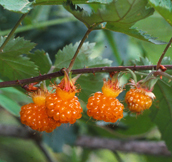
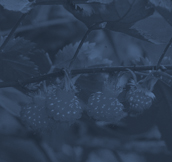 Rubus palmatus var. coptophyllus Rosaceae
Rubus palmatus var. coptophyllus Rosaceae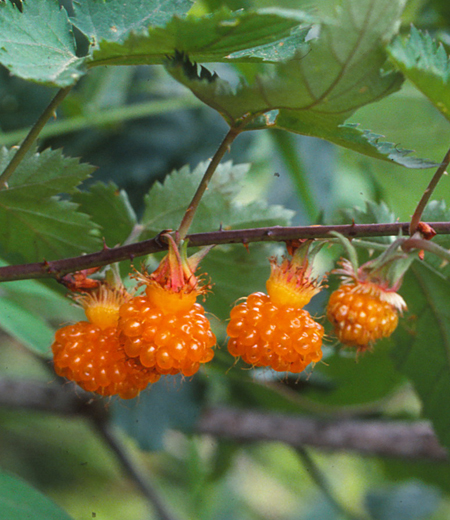 Deciduous shrubs found in sunny bright forest edges in mountains of Eastern Japan. Barks of young tree are bright green and turns to brown for adults. Have spines on branches and petioles (leaf stems). Have many branches. The Japanese name Momiji-ichigo literally meaning maple strawberry was named because the leaves resemble maple leaves. Leaves are 7 to 15 cm long in diameter and pinnate in three to five like palms. Petioles are long and leaves alternate with toothed margins (edges of leaves are like a teeth of saw). Leaves turn yellow in autumn. The blooming season is from March to May and bloom one white dropping flower and 3 cm in diameter on the branch grew on the previous year. Five petals are wide oval-shaped. Calyx has sharp tip. Fruits are 1 to 1.5 cm diameter collective flowers and turn orange as they ripen from June to July and edible.
Deciduous shrubs found in sunny bright forest edges in mountains of Eastern Japan. Barks of young tree are bright green and turns to brown for adults. Have spines on branches and petioles (leaf stems). Have many branches. The Japanese name Momiji-ichigo literally meaning maple strawberry was named because the leaves resemble maple leaves. Leaves are 7 to 15 cm long in diameter and pinnate in three to five like palms. Petioles are long and leaves alternate with toothed margins (edges of leaves are like a teeth of saw). Leaves turn yellow in autumn. The blooming season is from March to May and bloom one white dropping flower and 3 cm in diameter on the branch grew on the previous year. Five petals are wide oval-shaped. Calyx has sharp tip. Fruits are 1 to 1.5 cm diameter collective flowers and turn orange as they ripen from June to July and edible.
●Height about 1 to 2 m
●Place Trail 1, Trail 3 to 6, Mt.Inari, Minami-Takao -
Caesalpinia decapetala var. japonica Leguminosae
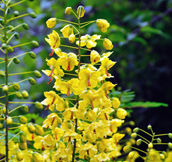
 Caesalpinia decapetala var. japonica Leguminosae
Caesalpinia decapetala var. japonica Leguminosae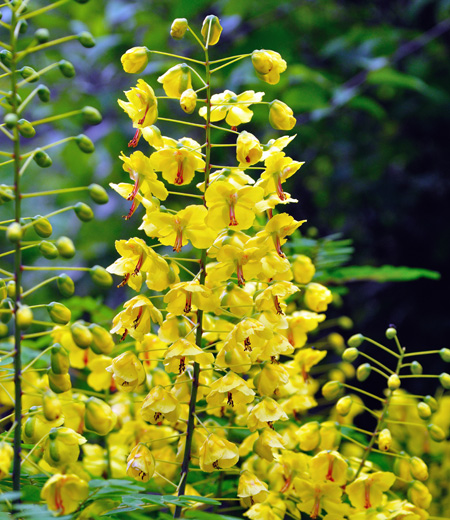 Deciduous woody vines (vines that sheds its leaves once in a year) found in forest edges at streamside in mountains. Branches grow like vines with many spines. Tangled branches resembling snakes, hence the Japanese name Jyaketsu-ibara literally meaning snake tied brambles. Oval-shaped leaflets (leaf-like parts of compound leaves) are in five to ten pairs and 20 to 40 cm long. The blooming season is from May to June, and has 20 to 30 cm long inflorescence on a branch and blooms many yellow flowers. Flowers are 3 cm in diameter and five petals. One petal is small with red spots. After flowering, bears 10 cm long, 3 cm width and shell-shaped. Turn brown as they ripen and crack in two and pop about 10 seeds. Seeds are about 1 cm oval-shaped and black.
Deciduous woody vines (vines that sheds its leaves once in a year) found in forest edges at streamside in mountains. Branches grow like vines with many spines. Tangled branches resembling snakes, hence the Japanese name Jyaketsu-ibara literally meaning snake tied brambles. Oval-shaped leaflets (leaf-like parts of compound leaves) are in five to ten pairs and 20 to 40 cm long. The blooming season is from May to June, and has 20 to 30 cm long inflorescence on a branch and blooms many yellow flowers. Flowers are 3 cm in diameter and five petals. One petal is small with red spots. After flowering, bears 10 cm long, 3 cm width and shell-shaped. Turn brown as they ripen and crack in two and pop about 10 seeds. Seeds are about 1 cm oval-shaped and black.
●Height Vines
●Place Jyataki -
Robinia pseudoacacia Leguminosae
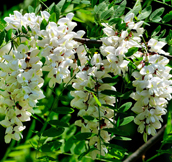
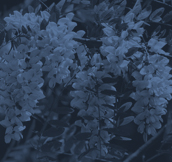 Robinia pseudoacacia Leguminosae
Robinia pseudoacacia Leguminosae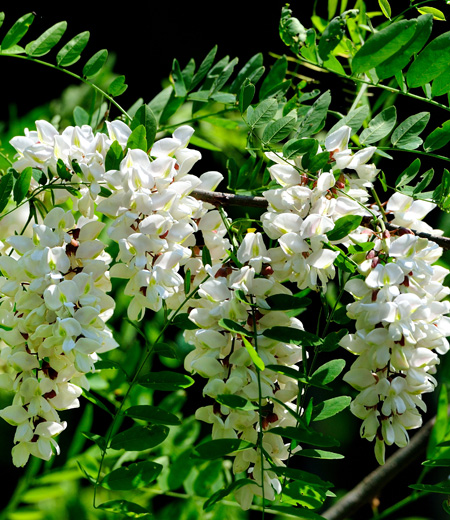 Deciduous small tree native to North America imported to Japan in early time of Meiji period. Planted throughout Japan and some became wild plants. Barks are light brown with net-like cracks. The Japanese name Hari-enju literally meaning needle Japanese pagoda tree because this plant resembles Japanese pagoda tree with spikes on branches. Another name is Nise-acacia literally meaning fake acacia because this plant blooms similar flower with acacia but with spines. 2.5 to 5 cm long and oval-shaped leaflets (leaf-like parts of compound leaves) are as one set. This becomes 12 to 25 cm long and alternate. The blooming season is May to June and inflorescence (flower stems) is dropping and bloom many white flowers. One flower is 2 cm long and smell sweet. Fruits are 5 to 20 cm long, 1.5 to 2 cm width and shell-shaped. Turn brown as they ripen.
Deciduous small tree native to North America imported to Japan in early time of Meiji period. Planted throughout Japan and some became wild plants. Barks are light brown with net-like cracks. The Japanese name Hari-enju literally meaning needle Japanese pagoda tree because this plant resembles Japanese pagoda tree with spikes on branches. Another name is Nise-acacia literally meaning fake acacia because this plant blooms similar flower with acacia but with spines. 2.5 to 5 cm long and oval-shaped leaflets (leaf-like parts of compound leaves) are as one set. This becomes 12 to 25 cm long and alternate. The blooming season is May to June and inflorescence (flower stems) is dropping and bloom many white flowers. One flower is 2 cm long and smell sweet. Fruits are 5 to 20 cm long, 1.5 to 2 cm width and shell-shaped. Turn brown as they ripen.
●Height about 15 to 20 m
●Place Oku-Takao -
Wisteria floribunda Leguminosae
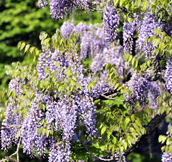
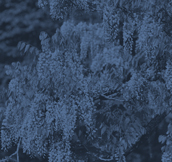 Wisteria floribunda Leguminosae
Wisteria floribunda Leguminosae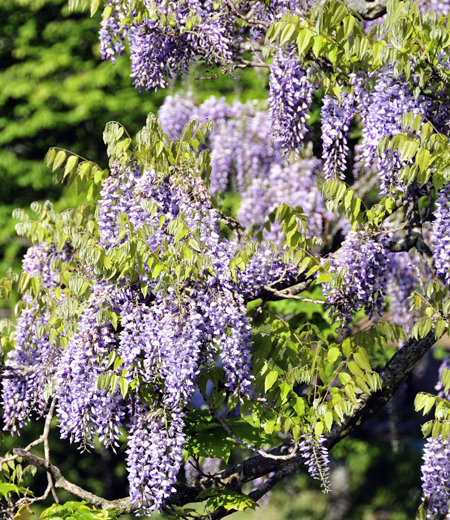 Deciduous small vines (vines that sheds its leaves once in a year) found in sunny forest edges in mountains. Twine adjacent plants. Barks of young tree are red-brown with diamond shallow cracks. Adults tree is greyish-brown with irregular cracks. Have eleven to nineteen oval-shaped leaflets (leaf-like parts of compound leaves) as one set. The length is 20 to 90 cm and bloom purple flowers on dropping florescent. Each flower is 1.5 to 2 cm long and yellow towards center. After flowering, bear fruits velvet-like hair densely placed on shells, 10 to 20 cm long. In October, dried as they ripen. Squeezed, split in two and pop seeds.
Deciduous small vines (vines that sheds its leaves once in a year) found in sunny forest edges in mountains. Twine adjacent plants. Barks of young tree are red-brown with diamond shallow cracks. Adults tree is greyish-brown with irregular cracks. Have eleven to nineteen oval-shaped leaflets (leaf-like parts of compound leaves) as one set. The length is 20 to 90 cm and bloom purple flowers on dropping florescent. Each flower is 1.5 to 2 cm long and yellow towards center. After flowering, bear fruits velvet-like hair densely placed on shells, 10 to 20 cm long. In October, dried as they ripen. Squeezed, split in two and pop seeds.
●Height Vines
●Place Oku-Takao -
Indigofera pseudo-tinctoria Leguminosae
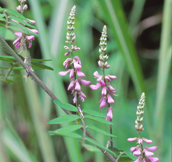
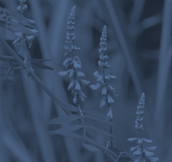 Indigofera pseudo-tinctoria Leguminosae
Indigofera pseudo-tinctoria Leguminosae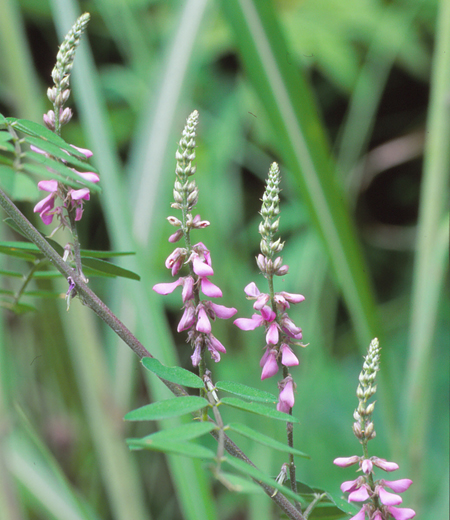 Deciduous shrubs (less than 1 m tall tree that sheds its leaves once in a year) found on riverbeds and riverbanks in grasslands, and at roadside. Looks like plants but it is hard to pull out from soils even if they are pulled with baby horse, hence the Japanese name Koma-tsunagi literally meaning tied to baby horse. Leaves are 0.8 to 2 cm elongated-shape and nine to eleven leaves are as one set and alternate. Leaves close in late afternoon. The blooming season is from July to August. Grow 7 cm long inflorescent from petioles and bloom light red-purple flowers. Flowers are 5 mm long with flower stalks. After flowering, bear 3 cm long shell-shaped cylindrical fruits. Turn to black as they ripe and split open and pop seeds.
Deciduous shrubs (less than 1 m tall tree that sheds its leaves once in a year) found on riverbeds and riverbanks in grasslands, and at roadside. Looks like plants but it is hard to pull out from soils even if they are pulled with baby horse, hence the Japanese name Koma-tsunagi literally meaning tied to baby horse. Leaves are 0.8 to 2 cm elongated-shape and nine to eleven leaves are as one set and alternate. Leaves close in late afternoon. The blooming season is from July to August. Grow 7 cm long inflorescent from petioles and bloom light red-purple flowers. Flowers are 5 mm long with flower stalks. After flowering, bear 3 cm long shell-shaped cylindrical fruits. Turn to black as they ripe and split open and pop seeds.
●Height about 50 to 90 cm
●Place Oku-Takao -
Albizia julibrissin(Silk Tree) Leguminosae
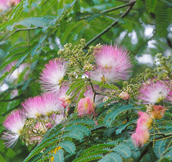
 Albizia julibrissin(Silk Tree) Leguminosae
Albizia julibrissin(Silk Tree) Leguminosae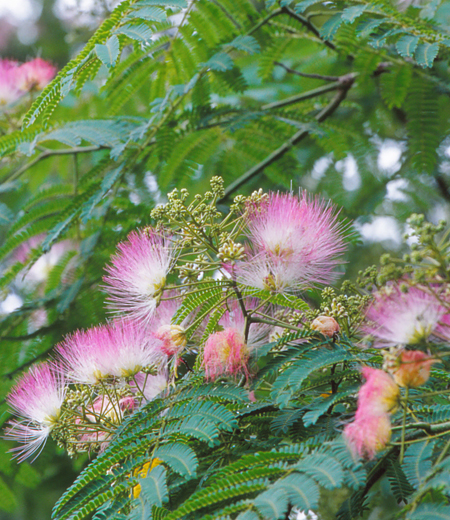 Deciduous small trees found in sunny forest edges and rough fields. Barks are grayish brown and lenticels (an opening that allows gases to be exchanged between air and the inner tissues of a plant) is distinct and trunks are about 30 cm wide. Leaves close at night and dropping style looks as if they are sleeping, hence the Japanese name Nemu-noki literally meaning sleeping tree. Have thirty to sixty leaflets (leaf-like parts of compound leaves) as one set and ten to twelve leaflets are alternate. Leaflets are 1 to1.7 cm long and 4 to 6 mm width. The blooming season is from June to July. Ten to twelve flowers are in clusters and bloom as one flower. Flower petals are 8 mm long but they stand out with pink thread-like stamens. After flowering, bear 10 to 15 cm long shell-shaped. Turn brown as they ripen and split open and pop ten to eighteen seeds.
Deciduous small trees found in sunny forest edges and rough fields. Barks are grayish brown and lenticels (an opening that allows gases to be exchanged between air and the inner tissues of a plant) is distinct and trunks are about 30 cm wide. Leaves close at night and dropping style looks as if they are sleeping, hence the Japanese name Nemu-noki literally meaning sleeping tree. Have thirty to sixty leaflets (leaf-like parts of compound leaves) as one set and ten to twelve leaflets are alternate. Leaflets are 1 to1.7 cm long and 4 to 6 mm width. The blooming season is from June to July. Ten to twelve flowers are in clusters and bloom as one flower. Flower petals are 8 mm long but they stand out with pink thread-like stamens. After flowering, bear 10 to 15 cm long shell-shaped. Turn brown as they ripen and split open and pop ten to eighteen seeds.
●Height about 5 to 10 m
●Place Ura-Takao, Oku-Takao, Minami-Takao -
Lespedeza bicolor Leguminosae
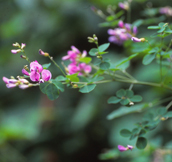
 Lespedeza bicolor Leguminosae
Lespedeza bicolor Leguminosae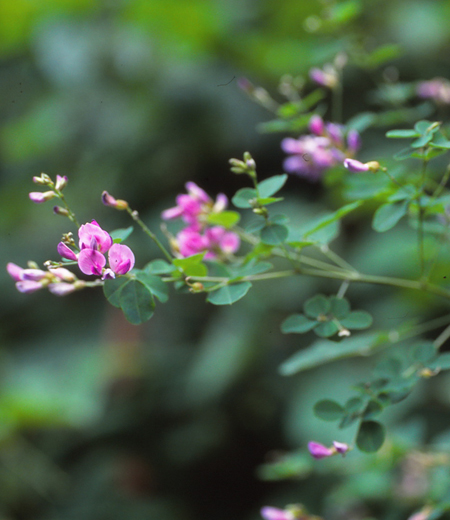 Deciduous shrubs found in sunny forest edge and grasslands in mountains. Is one of autumn seven herbs, when people say hagi, this is the plant widely used. Does not have trunk but have stems with many skinny branches and mostly upright. Three leaflets (leaf-like parts of compound leaves) are as one set and alternate. Leaflets are 2 to 4 cm long, egg-shaped with round tip and white hair on the back. The blooming season is from July to September. Long inflorescence grows from petioles on branches grown in a year and bloom 1.3 to 1.5 cm long red-purple flowers. Calyx is lobed in four. After flowering, bear 1 to 1.5 cm, shell-shaped flat oval-shaped fruits. Have one seed and ripen in October.
Deciduous shrubs found in sunny forest edge and grasslands in mountains. Is one of autumn seven herbs, when people say hagi, this is the plant widely used. Does not have trunk but have stems with many skinny branches and mostly upright. Three leaflets (leaf-like parts of compound leaves) are as one set and alternate. Leaflets are 2 to 4 cm long, egg-shaped with round tip and white hair on the back. The blooming season is from July to September. Long inflorescence grows from petioles on branches grown in a year and bloom 1.3 to 1.5 cm long red-purple flowers. Calyx is lobed in four. After flowering, bear 1 to 1.5 cm, shell-shaped flat oval-shaped fruits. Have one seed and ripen in October.
●Height about 1 to 2 m
●Place Oku-Takao, Minami-Takao -
Lespedeza cyrtobotrya Leguminosae
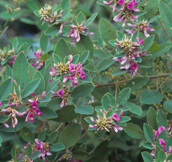
 Lespedeza cyrtobotrya Leguminosae
Lespedeza cyrtobotrya Leguminosae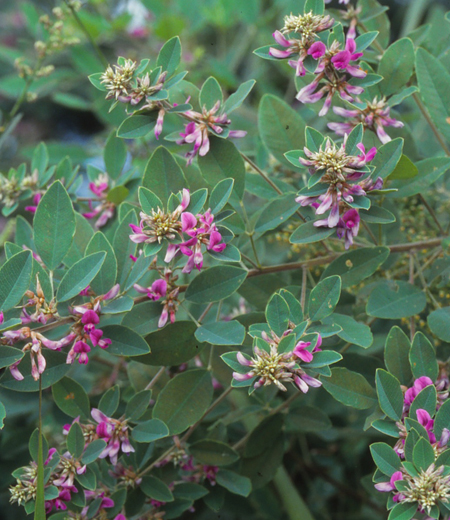 Deciduous shrubs found in sunny mountains. Barks of young trees are smooth and brown and lenticels (an opening that allows gases to be exchanged between air and the inner tissues of a plant) of adult trees become vertical. Compared to lespedeza bicolor, the shape of leaves are round, hence the Japanese name Maruba-hagi literally meaning round-shaped leaves lespedeza. Three leaflets (leaf-like parts of compound leaves) are as one set and alternate. Leaflets are 2 to 3 cm, oval-shaped, sag at tips and have fine whitish hair. The blooming season is from August to October and inflorescence (flower stem) grows from petioles and bloom 1 to 1.5 cm long red-purple flowers densely. Inflorescence is shorter than other plants in a lespedeza genus. After flowering, bear 6 to 7 mm long flat shell and oval shaped fruits. Have white hair inside and have one seed and ripen from October to November.
Deciduous shrubs found in sunny mountains. Barks of young trees are smooth and brown and lenticels (an opening that allows gases to be exchanged between air and the inner tissues of a plant) of adult trees become vertical. Compared to lespedeza bicolor, the shape of leaves are round, hence the Japanese name Maruba-hagi literally meaning round-shaped leaves lespedeza. Three leaflets (leaf-like parts of compound leaves) are as one set and alternate. Leaflets are 2 to 3 cm, oval-shaped, sag at tips and have fine whitish hair. The blooming season is from August to October and inflorescence (flower stem) grows from petioles and bloom 1 to 1.5 cm long red-purple flowers densely. Inflorescence is shorter than other plants in a lespedeza genus. After flowering, bear 6 to 7 mm long flat shell and oval shaped fruits. Have white hair inside and have one seed and ripen from October to November.
●Height about 1 to 3 m
●Place Oku-Takao, Minami-Takao -
Lespedeza buergeri Leguminosae
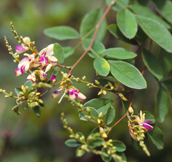
 Lespedeza buergeri Leguminosae
Lespedeza buergeri Leguminosae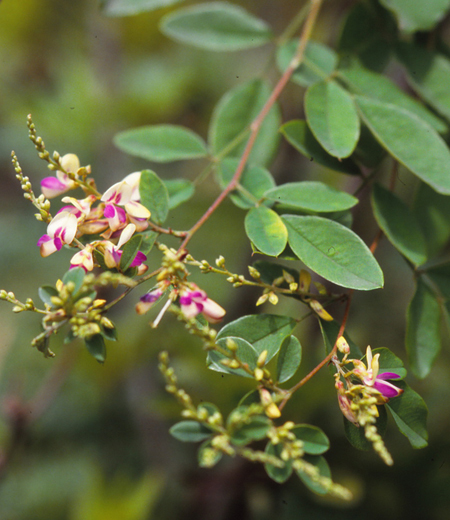 Deciduous shrubs found in sunny forest edges from mountains to hills. Barks are gray with vertical splits. Young branches are red-brown with fine hair. Trunk becomes 5 cm width. This is the most wooden plant in a lespedeza genus, hence the Japanese name Kihagi literally meaning tree lespedeza. Three leaflets (leaf-like parts of compound leaves) are as one set and alternate. Leaflets are 3 to 4 cm egg-shaped with pointed or round tips. The blooming season is from July to September. Bloom 1 cm long flower on inflorescence grow from petioles. Color is light yellow with red-purple stripes. After flowering, bear 1 to 1.5 cm flat shell and oval-shaped fruits with some hair. Have one seed inside and turn brown as they ripen.
Deciduous shrubs found in sunny forest edges from mountains to hills. Barks are gray with vertical splits. Young branches are red-brown with fine hair. Trunk becomes 5 cm width. This is the most wooden plant in a lespedeza genus, hence the Japanese name Kihagi literally meaning tree lespedeza. Three leaflets (leaf-like parts of compound leaves) are as one set and alternate. Leaflets are 3 to 4 cm egg-shaped with pointed or round tips. The blooming season is from July to September. Bloom 1 cm long flower on inflorescence grow from petioles. Color is light yellow with red-purple stripes. After flowering, bear 1 to 1.5 cm flat shell and oval-shaped fruits with some hair. Have one seed inside and turn brown as they ripen.
●Height about 2 to 3 m
●Place Trail 1, Trail 5 -
Skimmia japonica Rutaceae
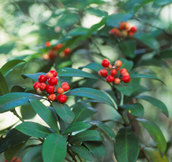
 Skimmia japonica Rutaceae
Skimmia japonica Rutaceae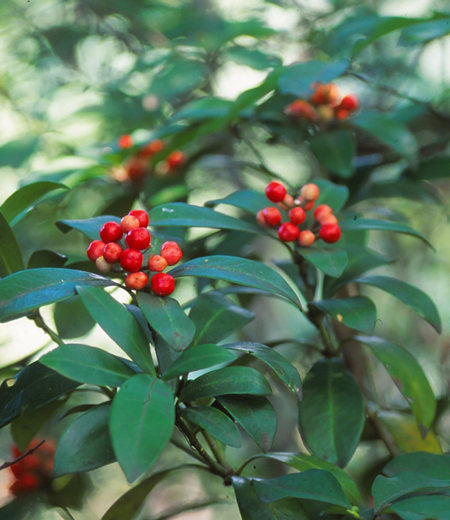 Evergreen shrubs (less than 1 m tall tree with green leaves throughout a year) found in forests in mountains. In Mt. Takao, found in fir tree forests near mountain ridges. Grow in mountain and braches and leaves resemble skimmia, hence the Japanese name Miyama-sikimi literally meaning deep in the mountain skimmia. Leaves are 4 to 9 cm long, 3 to 5 cm width, oval shaped and mostly at the tips of stems. Texture is leathery with shiny surface and leaf glands (small glands to release secretion) are placed irregularly. The blooming season is March to May and have male and female flowers. Bloom 1 cm in diameter white flowers densely on inflorescence grows from petioles. After flowering, bear 5 to 8 mm spherical shaped fruits and have one seed inside. Turn shiny red as they ripen. The entire plant has poisonous ingredients called skimmianine and is contained in fruits the most. Cause cramps when eaten by mistake.
Evergreen shrubs (less than 1 m tall tree with green leaves throughout a year) found in forests in mountains. In Mt. Takao, found in fir tree forests near mountain ridges. Grow in mountain and braches and leaves resemble skimmia, hence the Japanese name Miyama-sikimi literally meaning deep in the mountain skimmia. Leaves are 4 to 9 cm long, 3 to 5 cm width, oval shaped and mostly at the tips of stems. Texture is leathery with shiny surface and leaf glands (small glands to release secretion) are placed irregularly. The blooming season is March to May and have male and female flowers. Bloom 1 cm in diameter white flowers densely on inflorescence grows from petioles. After flowering, bear 5 to 8 mm spherical shaped fruits and have one seed inside. Turn shiny red as they ripen. The entire plant has poisonous ingredients called skimmianine and is contained in fruits the most. Cause cramps when eaten by mistake.
●Height about 1 to 1.5m
●Place Trail 1, Trail 3 and 4, Mt.Inari -
Mallotus japonicus Euphorbiaceae
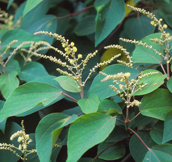
 Mallotus japonicus Euphorbiaceae
Mallotus japonicus Euphorbiaceae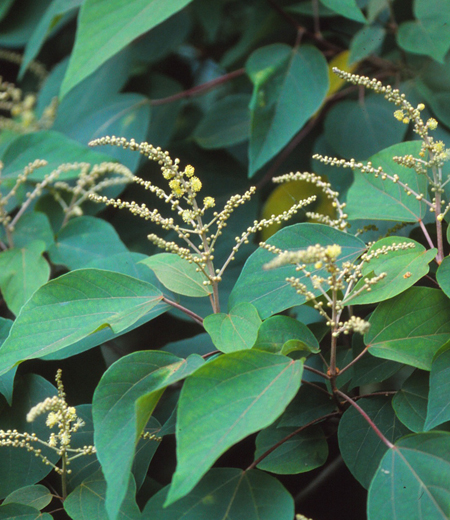 Deciduous shrubs found at roadside and forest edges in mountains. The Japanese name have rees found in sunny forest edges and deforested areas in mountains. Barks of young tree are grayish-brown with fine lines and it becomes net-like pattern for adults tree. Trunk grows up to about 50 cm thick. Leaves are 7 to 20 cm long and wide oval-shaped. Have long petioles and alternate. Young leaves have red hair densely placed and used to wrap foods like daimyo oak, hence the Japanese name Akame-gashiwa literally meaning red sprout daimyo oak. The blooming season is from June to July. Male flowers and female flowers are on the different stems with no petals. Male flowers are 7 to 20 cm long inflorescence (flowers on a stem) and bloom with yellow stamens. Female flowers have short inflorescence with red pistils. Fruits are 8 mm in diameter, oval-shaped and turn brown as they ripen from September to October.
Deciduous shrubs found at roadside and forest edges in mountains. The Japanese name have rees found in sunny forest edges and deforested areas in mountains. Barks of young tree are grayish-brown with fine lines and it becomes net-like pattern for adults tree. Trunk grows up to about 50 cm thick. Leaves are 7 to 20 cm long and wide oval-shaped. Have long petioles and alternate. Young leaves have red hair densely placed and used to wrap foods like daimyo oak, hence the Japanese name Akame-gashiwa literally meaning red sprout daimyo oak. The blooming season is from June to July. Male flowers and female flowers are on the different stems with no petals. Male flowers are 7 to 20 cm long inflorescence (flowers on a stem) and bloom with yellow stamens. Female flowers have short inflorescence with red pistils. Fruits are 8 mm in diameter, oval-shaped and turn brown as they ripen from September to October.
●Height about 5 to 15 m
●Place Trail 1 -
Rhus trichocarpa Anacardiaceae
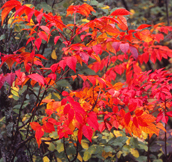
 Rhus trichocarpa Anacardiaceae
Rhus trichocarpa Anacardiaceae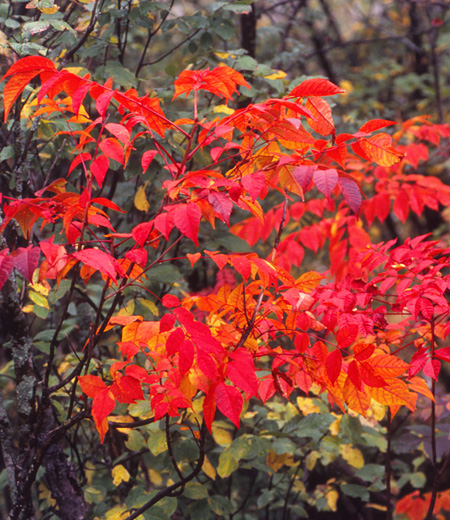 They are deciduous small trees or shrubs that grow wild in the pool of the sunny forests in the mountain areas. They contain sunbstance called ‘urushiol’, which we touch the branch or the leaf, resulting in our getting a rash from lacquer. Cortex of the young trees is tinged with gray-white color, and diamond-shaped lenticel stands out, while the one of the adult trees is split shallow vertically with the dark-brown patterns. The trunk is about 5 cm wide. The leaf is an imparipinnately compound leaf, consisting of 9 to 17 lobules as one. Lobulus is egged-shaped about 5 to 12 cm long, 3 to 6 cm wide with the sharp top, and only young leaf has a sawtooth (Kyoshi: tooth-like rough part like a saw at the root of a leaf) at the edge. They turn into red color in autumn. The blossom seasons are about May to June and a dioecious plant (Shiyuuisyu). From the side of the leaf, does inflorescence (Kajo: stalk blooming flowers), about 15 to 25 cm long, sprout with small yellow flowers. The seeds are a collapsed spherical shape, about 6 mm in diameter, and get matured to turn into yellowish brown in about September to October. The leaves are tinged with red.
They are deciduous small trees or shrubs that grow wild in the pool of the sunny forests in the mountain areas. They contain sunbstance called ‘urushiol’, which we touch the branch or the leaf, resulting in our getting a rash from lacquer. Cortex of the young trees is tinged with gray-white color, and diamond-shaped lenticel stands out, while the one of the adult trees is split shallow vertically with the dark-brown patterns. The trunk is about 5 cm wide. The leaf is an imparipinnately compound leaf, consisting of 9 to 17 lobules as one. Lobulus is egged-shaped about 5 to 12 cm long, 3 to 6 cm wide with the sharp top, and only young leaf has a sawtooth (Kyoshi: tooth-like rough part like a saw at the root of a leaf) at the edge. They turn into red color in autumn. The blossom seasons are about May to June and a dioecious plant (Shiyuuisyu). From the side of the leaf, does inflorescence (Kajo: stalk blooming flowers), about 15 to 25 cm long, sprout with small yellow flowers. The seeds are a collapsed spherical shape, about 6 mm in diameter, and get matured to turn into yellowish brown in about September to October. The leaves are tinged with red.
●Height about 3 to 8 m
●Place Trail 1 and 2,Trail 4, Mt.Inari, Minami-Takao, Oku-Takao -
Acer palmatum(Japanese maple) Aceraceae
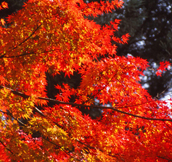
 Acer palmatum(Japanese maple) Aceraceae
Acer palmatum(Japanese maple) Aceraceae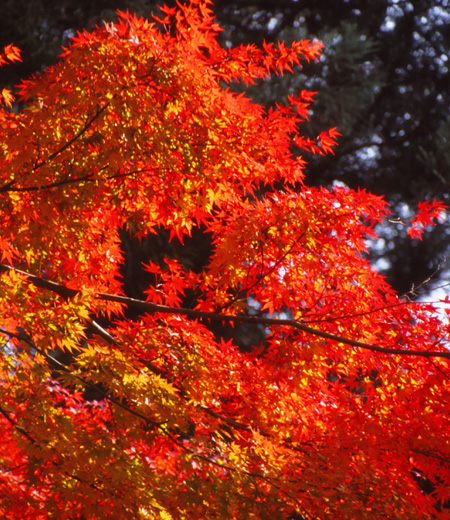 They are a deciduous tall tree that grows wild at the sunny slanting surfaces in the mountain area and at humid places along the mountain streams. They are also utilized for garden trees, park trees, and Bonsai, therefore, also called ‘Acer palmatum Thunberg’ or ‘Acer palmatum’. Cortex of young trees is tinged green and smooth feeling to touch, while adult trees turn into gray color and are split vertically. The trunk is about 60 cm wide. The leaves are split into 5 to 7 like our padded palm, and then people use the split portions to count. This is the reason for the name. Autumn leaves of Aceraceae plant vary like red, yellow, orange, and brown colors with much variation. Acer palmatum in the woods has the leaves with their tip red due to sunshine and yellow inside. The blossom seasons are about April to May. As they are monoecious trees, red flowers blossom at the top of the branch
They are a deciduous tall tree that grows wild at the sunny slanting surfaces in the mountain area and at humid places along the mountain streams. They are also utilized for garden trees, park trees, and Bonsai, therefore, also called ‘Acer palmatum Thunberg’ or ‘Acer palmatum’. Cortex of young trees is tinged green and smooth feeling to touch, while adult trees turn into gray color and are split vertically. The trunk is about 60 cm wide. The leaves are split into 5 to 7 like our padded palm, and then people use the split portions to count. This is the reason for the name. Autumn leaves of Aceraceae plant vary like red, yellow, orange, and brown colors with much variation. Acer palmatum in the woods has the leaves with their tip red due to sunshine and yellow inside. The blossom seasons are about April to May. As they are monoecious trees, red flowers blossom at the top of the branch
●Height about 10 to 20 m
●Place Trail 1 to 4 -
Acer crataegifolium Aceraceae
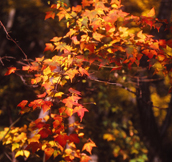
 Acer crataegifolium Aceraceae
Acer crataegifolium Aceraceae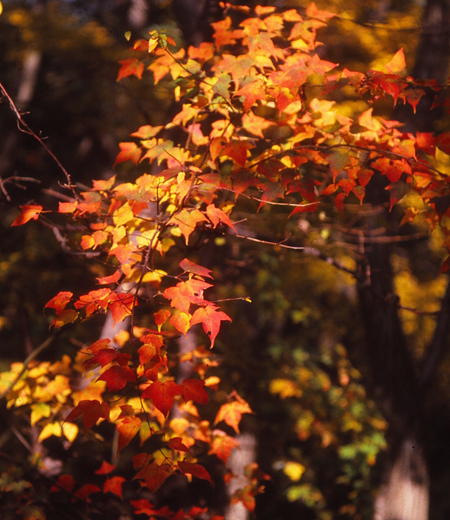 They are deciduous small trees or shrubs that grow wild at sunny arid places such as at the hilly areas and in the mountain districts. Cortex is tinged with green, which resembles Cucumis melo var. makuwa and this is the reason for their name ‘Acer crata egitorium’. The leaves are the smallest among the group of Aceraceae plant, about 4 to 8 cm long. The blossom seasons are about April to May. As they are monoecious trees, pale yellow flowers blossom about 8 mm long. A male flower attaches to the scion shooting among the sprouted leaves, while a female flower at the top of the branch. In summer the group of Aceraceae plant transforms themselves into the seeds named ‘samara or winged seed’ with the wings (Yokuka) so that they can fly on the wind. Also, they are double-divided paper fan-like shaped (Uchiwa), the seeds of this species are tinged with red and show up very well. In autumn the leaves turn to yellow to be autumn color leaves. The leaves of Acer rufinerve, which resembles with cortex, turn to red.
They are deciduous small trees or shrubs that grow wild at sunny arid places such as at the hilly areas and in the mountain districts. Cortex is tinged with green, which resembles Cucumis melo var. makuwa and this is the reason for their name ‘Acer crata egitorium’. The leaves are the smallest among the group of Aceraceae plant, about 4 to 8 cm long. The blossom seasons are about April to May. As they are monoecious trees, pale yellow flowers blossom about 8 mm long. A male flower attaches to the scion shooting among the sprouted leaves, while a female flower at the top of the branch. In summer the group of Aceraceae plant transforms themselves into the seeds named ‘samara or winged seed’ with the wings (Yokuka) so that they can fly on the wind. Also, they are double-divided paper fan-like shaped (Uchiwa), the seeds of this species are tinged with red and show up very well. In autumn the leaves turn to yellow to be autumn color leaves. The leaves of Acer rufinerve, which resembles with cortex, turn to red.
●Height about 6 to 8 m
●Place Trail and 2, Trail 4, Minami-Takao -
Acer amoenum Aceraceae
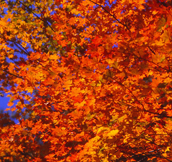
 Acer amoenum Aceraceae
Acer amoenum Aceraceae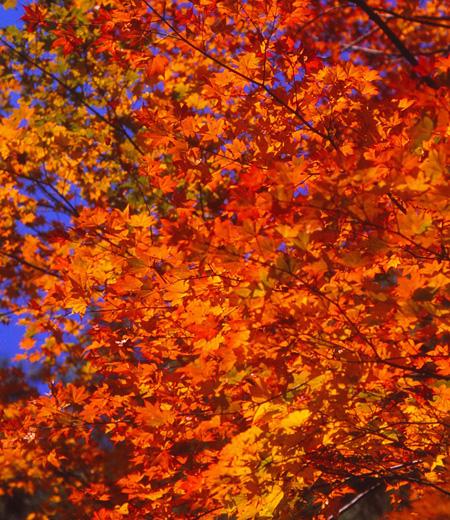 They are a deciduous tall tree that grows wild on a sunny but a little bit humid slope in the mountain area. Cortexes of young trees are tinged with green, while adult ones turn into gray-brown in color with shallow splits vertically. The trunk is about 60 cm wide. As they are one of variation species of Acer palmatum, the leaves are pretty larger. This is how they have another name ‘Acer amoenum’. The leaves are about 7 to 11 cm long, split into 5 to 9 like our padded palm with the sharp top and a finely full deck sawtooth (Kyoshi: tooth-like rough part like a saw at the root of a leaf) at the edge. The blossom seasons are about April to May and they are monoecious trees. The ears of small 15 to 30 flowers have a male flower and an androgynous flower (Ryoseika: 1 flower has both a male stamen and a female stamen) bloom mixed. They have 5 flower petals tinged wth pale yellow and sometimes tinged with purple. In summer, they bear the winged seeds with the wings. Their characteristics of leaves are thin, bearing sparse trichome on the surface as well as dense trichome at the back of it. The blossom seasons are about May to June, when
They are a deciduous tall tree that grows wild on a sunny but a little bit humid slope in the mountain area. Cortexes of young trees are tinged with green, while adult ones turn into gray-brown in color with shallow splits vertically. The trunk is about 60 cm wide. As they are one of variation species of Acer palmatum, the leaves are pretty larger. This is how they have another name ‘Acer amoenum’. The leaves are about 7 to 11 cm long, split into 5 to 9 like our padded palm with the sharp top and a finely full deck sawtooth (Kyoshi: tooth-like rough part like a saw at the root of a leaf) at the edge. The blossom seasons are about April to May and they are monoecious trees. The ears of small 15 to 30 flowers have a male flower and an androgynous flower (Ryoseika: 1 flower has both a male stamen and a female stamen) bloom mixed. They have 5 flower petals tinged wth pale yellow and sometimes tinged with purple. In summer, they bear the winged seeds with the wings. Their characteristics of leaves are thin, bearing sparse trichome on the surface as well as dense trichome at the back of it. The blossom seasons are about May to June, when
●Height about 10 to 13 m
●Place Trail 1 to 4 -
Acer carpinifolium Aceraceae
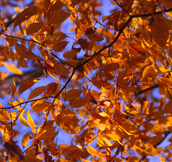
 Acer carpinifolium Aceraceae
Acer carpinifolium Aceraceae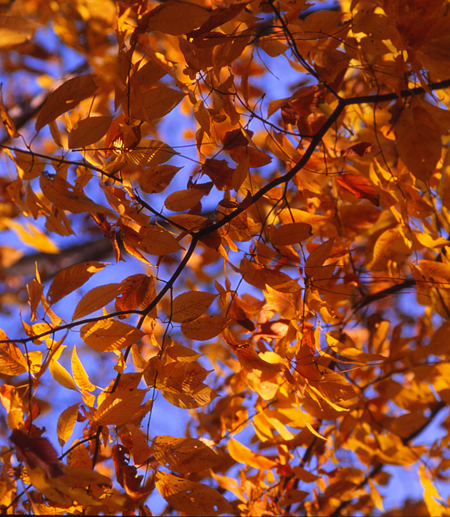 They are a deciduous tall tree that grows wild at little humid places like in the valley in the mountain area. Mostly they grow in cluster along the mountain streams. The trunk is about 15 cm wide. Cortexes are tinged with gray, but when they are young ones their rash-like lentice (Himoku) stands out. When it comes to Adult trees, they got split vertically. The leaves are elliptically-shaped about 7 to 15 cm long, about 3 to 7 cm wide with the rough sawtooth (Kyoshi: tooth-like rough part like a saw at the root of a leaf) at the edge. Unlike the other ordinary Aceraceae plants, their characteristic is they don’t have padded palm shaped splits. The blossom seasons are about May and a dioecious plant (Shiyuuisyu). Inflorescence (Kajo: stalk blooming flowers) grown from the side of the leaf, about 8 cm long, bears a small pale yellow flower about 1 cm long. The seeds are the ones with wings, which is common among the group of Acer, and get matured in August to October. The name comes from that the appearance of the opened seed looks like the one of the flying plovers.
They are a deciduous tall tree that grows wild at little humid places like in the valley in the mountain area. Mostly they grow in cluster along the mountain streams. The trunk is about 15 cm wide. Cortexes are tinged with gray, but when they are young ones their rash-like lentice (Himoku) stands out. When it comes to Adult trees, they got split vertically. The leaves are elliptically-shaped about 7 to 15 cm long, about 3 to 7 cm wide with the rough sawtooth (Kyoshi: tooth-like rough part like a saw at the root of a leaf) at the edge. Unlike the other ordinary Aceraceae plants, their characteristic is they don’t have padded palm shaped splits. The blossom seasons are about May and a dioecious plant (Shiyuuisyu). Inflorescence (Kajo: stalk blooming flowers) grown from the side of the leaf, about 8 cm long, bears a small pale yellow flower about 1 cm long. The seeds are the ones with wings, which is common among the group of Acer, and get matured in August to October. The name comes from that the appearance of the opened seed looks like the one of the flying plovers.
●Height about 8 to 10 m
●Place Trail 1 and 2, Trail 4, Trail 6, Ura-Takao -
Akebia quinata Lardizabalaceae
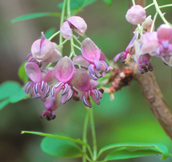
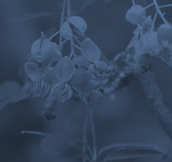 Akebia quinata Lardizabalaceae
Akebia quinata Lardizabalaceae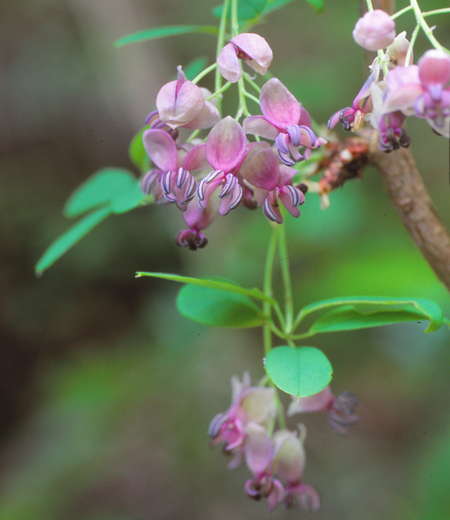 Found in mountains and fields. Are well known for the edible fruits and fruits skin. Fruits open when ripen, hence the Japanese name Akebi literally meaning open fruits. In spring, bloom light purple flower on flower stalk from young leaves. Have male flower on the tip of flower stalk and female flowers on the lower parts of flower stalks. Female flowers are 3 cm long and twice the size of male flowers. Have stick-like stamens from the center of three sepals like petals. Leaves are palmate compound leaves and five small oval-shaped leaves are on the long leaf stalk. If leaves are trifoliate compound leaf, it is akebia trifoliata with three leaves. Fruits are 5 to 10 cm long and small oval-shaped. In September, turn purple and split open vertically. Fruits are edible raw but fresh but it is recommended to heat the skin.
Found in mountains and fields. Are well known for the edible fruits and fruits skin. Fruits open when ripen, hence the Japanese name Akebi literally meaning open fruits. In spring, bloom light purple flower on flower stalk from young leaves. Have male flower on the tip of flower stalk and female flowers on the lower parts of flower stalks. Female flowers are 3 cm long and twice the size of male flowers. Have stick-like stamens from the center of three sepals like petals. Leaves are palmate compound leaves and five small oval-shaped leaves are on the long leaf stalk. If leaves are trifoliate compound leaf, it is akebia trifoliata with three leaves. Fruits are 5 to 10 cm long and small oval-shaped. In September, turn purple and split open vertically. Fruits are edible raw but fresh but it is recommended to heat the skin.
●Season Mid April to Mid May
●Height Vines
●Place Ura-Takao -
Cercidiphyllum japonicum Cercidiphyllaceae
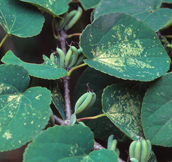
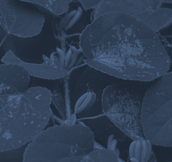 Cercidiphyllum japonicum Cercidiphyllaceae
Cercidiphyllum japonicum Cercidiphyllaceae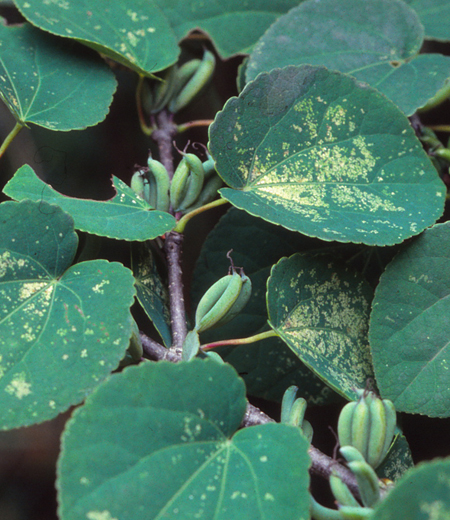 They are a deciduous tall tree that grows wild along the humid valley in the mountain area and smell sweet. Cortex of their young trees is tinged with reddish brown and smooth, while the one of their adult trees turn into dark gray-brown with the trunk being about 2 m wide. As for old trees, they are split shallow vertically and cortex is finely peeled off. The leaf is round heart-shaped about 3 to 8 cm long with a dull gyrose sawtooth at the edge (sawtooth: Kyoshi, serrated edges like a saw- serrated edges at the tip of a leaf) and with the back in white like being flour-coated. The blossom seasons are about March to May and a dioecious plant (Shiyuuisyu). The flower blossoms with no flower petals or sepals before the leaves sprout. A male flower has lots of male stamen tinged with red-purple about 4 mm long, while a female flower bears 3 to 4 of a female stamen tinged with pale showy pink. The seeds are shaped like a banana rolled backward about 1.5 cm long. They get matured into black-purple color in autumn.
They are a deciduous tall tree that grows wild along the humid valley in the mountain area and smell sweet. Cortex of their young trees is tinged with reddish brown and smooth, while the one of their adult trees turn into dark gray-brown with the trunk being about 2 m wide. As for old trees, they are split shallow vertically and cortex is finely peeled off. The leaf is round heart-shaped about 3 to 8 cm long with a dull gyrose sawtooth at the edge (sawtooth: Kyoshi, serrated edges like a saw- serrated edges at the tip of a leaf) and with the back in white like being flour-coated. The blossom seasons are about March to May and a dioecious plant (Shiyuuisyu). The flower blossoms with no flower petals or sepals before the leaves sprout. A male flower has lots of male stamen tinged with red-purple about 4 mm long, while a female flower bears 3 to 4 of a female stamen tinged with pale showy pink. The seeds are shaped like a banana rolled backward about 1.5 cm long. They get matured into black-purple color in autumn.
●Height about 20 to 30 m
●Place Trail 1 to 4, Trail 6, Ura-Takao -
Cleyera japonica Theaceae
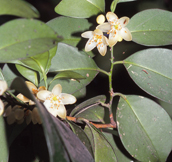
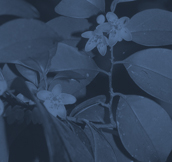 Cleyera japonica Theaceae
Cleyera japonica Theaceae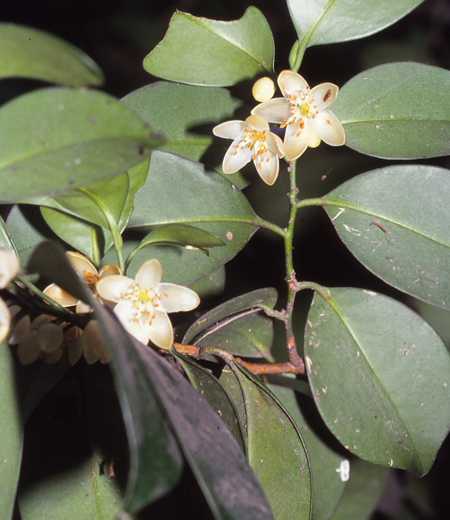 They are an evergreen tree that grows wild in the mountain areas. Cortex is tinged with dark red-brown color and smooth feeling to touch with many small rounded lenticels. Th trunk grows to be about 30 centimeters long. New branches are green and winter buds sprouting from the limb are curved widely like a hook shape. The branches and leaves are utilized to produce a branch of the sacred tree (Tamagushi: one of ritual articles made of branch of a sacred tree (esp. sakaki) with paper or cotton strips attached), and therefore are indispensable trees to shrine rituals, which this is why they are frequently planted at Shinto shrines. The leaves are tall elliptically-shaped about 8 to 10 cm long, about 2 to 4 cm wide, thick and shiny. The blossom seasons are about June to July, when 1 to 3 of the flowers about 1.5 cm in diameter beside the leaf bloom downwards. They bear 5 flower petals, which are white color at first and then later, are tinged with yellow. The seeds are a spherical shape about 7 mm in diameter with male stamen’ styles remaining at the top. The seeds are green color at first and when they get matured in November and December, they are tinged with a black-purple.
They are an evergreen tree that grows wild in the mountain areas. Cortex is tinged with dark red-brown color and smooth feeling to touch with many small rounded lenticels. Th trunk grows to be about 30 centimeters long. New branches are green and winter buds sprouting from the limb are curved widely like a hook shape. The branches and leaves are utilized to produce a branch of the sacred tree (Tamagushi: one of ritual articles made of branch of a sacred tree (esp. sakaki) with paper or cotton strips attached), and therefore are indispensable trees to shrine rituals, which this is why they are frequently planted at Shinto shrines. The leaves are tall elliptically-shaped about 8 to 10 cm long, about 2 to 4 cm wide, thick and shiny. The blossom seasons are about June to July, when 1 to 3 of the flowers about 1.5 cm in diameter beside the leaf bloom downwards. They bear 5 flower petals, which are white color at first and then later, are tinged with yellow. The seeds are a spherical shape about 7 mm in diameter with male stamen’ styles remaining at the top. The seeds are green color at first and when they get matured in November and December, they are tinged with a black-purple.
●Height about 10 to 12 m
●Place Trail 1 to 3 -
Eurha japonica Theaceae
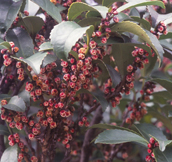
 Eurha japonica Theaceae
Eurha japonica Theaceae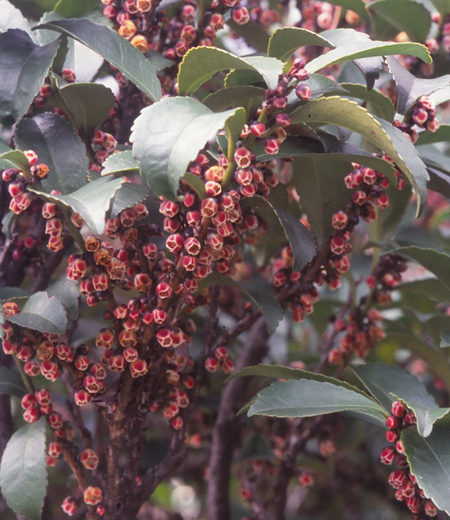 They are common deciduous small trees or shrubs that grow wild at the mountain areas. Cortex is tinged with gray-brown or black ash color, smooth feeling to touch, but is irregularly finely wrinkled a lot. The trunk grows to be about 20 cm wide. They are also planted for garden trees, green hedges, and park trees. Their wood building materials are so compact tissue that they are utilized for appliance material. The leaves are elliptically-shaped about 3 to 8 cm long, about 1.5 to 3 cm wide with the sharp top as well as a sawtooth (Kyoshi: tooth-like rough part like a saw at the root of a leaf) at the edge. Their characteristic is the leaves are thick and shiny, hard feeling to touch. The blossom, seasons are March to April, and a dioecious plant (Shiyuuisyu). They bear 1 to 3 of the small bell-shaped flowers downwards beside the leaves. The flowers are about 5 to 6 mm with female flowers being s little smaller than male flowers. The flower is tinged with yellowish white and has a particular odor. The seeds are a spherical shape about 4 to 5 mm in diameter, and get matured in October to November to turn into black-purple.
They are common deciduous small trees or shrubs that grow wild at the mountain areas. Cortex is tinged with gray-brown or black ash color, smooth feeling to touch, but is irregularly finely wrinkled a lot. The trunk grows to be about 20 cm wide. They are also planted for garden trees, green hedges, and park trees. Their wood building materials are so compact tissue that they are utilized for appliance material. The leaves are elliptically-shaped about 3 to 8 cm long, about 1.5 to 3 cm wide with the sharp top as well as a sawtooth (Kyoshi: tooth-like rough part like a saw at the root of a leaf) at the edge. Their characteristic is the leaves are thick and shiny, hard feeling to touch. The blossom, seasons are March to April, and a dioecious plant (Shiyuuisyu). They bear 1 to 3 of the small bell-shaped flowers downwards beside the leaves. The flowers are about 5 to 6 mm with female flowers being s little smaller than male flowers. The flower is tinged with yellowish white and has a particular odor. The seeds are a spherical shape about 4 to 5 mm in diameter, and get matured in October to November to turn into black-purple.
●Height about 3 to 7 m
●Place Trail 1 to 3 -
Camellia japonica Theaceae
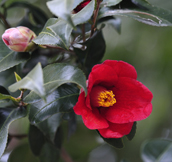
 Camellia japonica Theaceae
Camellia japonica Theaceae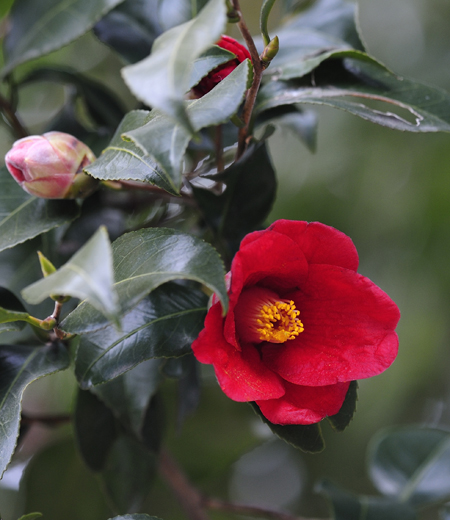 They are an evergreen broad-leaved tree that grows wild around hilly district and low mountain areas. Cortex is gray-brown in color and smooth feeling to touch, but when fungus or algae adhere to the surface of cortex, it sometimes gets patchy pattern of green and white. The trunk grows to be 30 to 40 cm wide. The tree itself is tinged with brownish-red, and utilized for architectural material and Sculpture wood. People can extract camellia oil from the seeds. The leaves are elliptically-shaped about 5 to 10 cm long, about 3 to 6 cm wide with the sharp top as well as a sawtooth (Kyoshi: tooth-like rough part like a saw at the root of a leaf) at the edge. Their characteristic is the leaves are thick and hard feeling to touch. The blossom, seasons are about November to December, or about February to April. They bear 1 to 2 of the large red flowers about 5 cm in diameter beside the leaf of the limb. The flower consists of 5 flower petals as one, with the bottom part of male stamen sticking together and a tea whisk-shape. The seeds are a spherical shape about 2 to 2.5 cm in diameter, and when they get matured they are split to sprout out 2 to 3 of brownish-red seeds.
They are an evergreen broad-leaved tree that grows wild around hilly district and low mountain areas. Cortex is gray-brown in color and smooth feeling to touch, but when fungus or algae adhere to the surface of cortex, it sometimes gets patchy pattern of green and white. The trunk grows to be 30 to 40 cm wide. The tree itself is tinged with brownish-red, and utilized for architectural material and Sculpture wood. People can extract camellia oil from the seeds. The leaves are elliptically-shaped about 5 to 10 cm long, about 3 to 6 cm wide with the sharp top as well as a sawtooth (Kyoshi: tooth-like rough part like a saw at the root of a leaf) at the edge. Their characteristic is the leaves are thick and hard feeling to touch. The blossom, seasons are about November to December, or about February to April. They bear 1 to 2 of the large red flowers about 5 cm in diameter beside the leaf of the limb. The flower consists of 5 flower petals as one, with the bottom part of male stamen sticking together and a tea whisk-shape. The seeds are a spherical shape about 2 to 2.5 cm in diameter, and when they get matured they are split to sprout out 2 to 3 of brownish-red seeds.
●Height about 5 to 15m
●Place Trail 1 to 3, Jyataki -
Stachyurus praecox Stachyuraceae
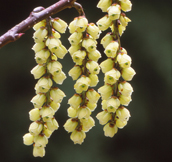
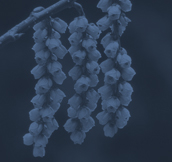 Stachyurus praecox Stachyuraceae
Stachyurus praecox Stachyuraceae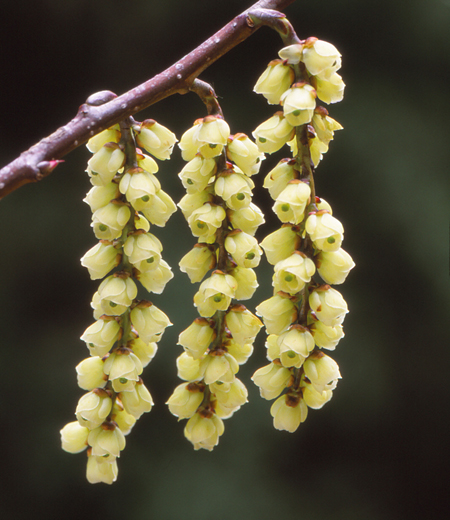 They are a deciduous shrub that grows wild in the forests in mountain areas. Cortex is tinged with dark brown and adult trees get shriveled vertically. The branches that extend are tinged with reddish green and slightly shiny. The leaves are egged-shaped about 6 to 12 cm long, about 3 to 6 cm wide with the sharp top as well as with a sawtooth (sawtooth: Kyoshi, serrated edges like a saw serrated edges at the tip of a leaf). The blossom seasons are about March to April and a dioecious plant (Shiyuuisyu). Before the leaves shoot, they sprout inflorescence (Kajo: stalk blooming flowers) about 4 to 10 cm to dangle white many hanging bell-shaped flowers about 8 mm long. Male flowers are inged with yellow, and female flowers are yellowish green. The seeds are elliptically-shaped spherical form tinged with indigo blue about 8 mm long. The seeds turn to green from yellow to get matured about in July to October. The reason for their name is that people use these seeds as a substitute for sumac gallnut (Fushi: gallnut of Japanese sumac) to make black colorant. This is why they are named ‘Stachyurus praecox’ (Kibushi).
They are a deciduous shrub that grows wild in the forests in mountain areas. Cortex is tinged with dark brown and adult trees get shriveled vertically. The branches that extend are tinged with reddish green and slightly shiny. The leaves are egged-shaped about 6 to 12 cm long, about 3 to 6 cm wide with the sharp top as well as with a sawtooth (sawtooth: Kyoshi, serrated edges like a saw serrated edges at the tip of a leaf). The blossom seasons are about March to April and a dioecious plant (Shiyuuisyu). Before the leaves shoot, they sprout inflorescence (Kajo: stalk blooming flowers) about 4 to 10 cm to dangle white many hanging bell-shaped flowers about 8 mm long. Male flowers are inged with yellow, and female flowers are yellowish green. The seeds are elliptically-shaped spherical form tinged with indigo blue about 8 mm long. The seeds turn to green from yellow to get matured about in July to October. The reason for their name is that people use these seeds as a substitute for sumac gallnut (Fushi: gallnut of Japanese sumac) to make black colorant. This is why they are named ‘Stachyurus praecox’ (Kibushi).
●Height about 3 to 5 m
●Place Trail 1, Trail 5, Ura-Takao, Oku-Takao, Minami-Takao -
Alangium platanifolium var. trilobum Alangiaceae
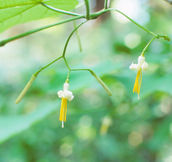
 Alangium platanifolium var. trilobum Alangiaceae
Alangium platanifolium var. trilobum Alangiaceae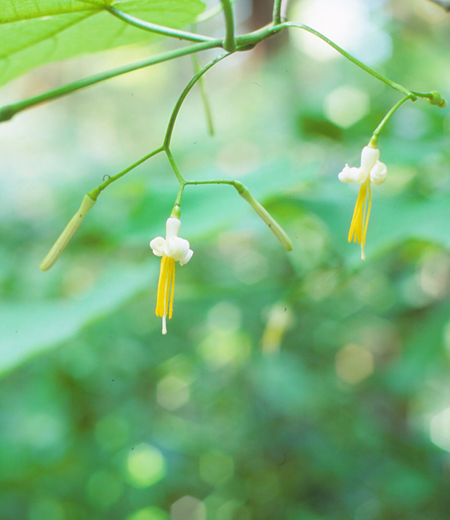
They are deciduous shrub that grow in bushes of mountain areas. As the shape of their leaves are similar to the ones of cucurbit. Then they are named. Cortex is tinged with gray color with many lenticels and young leaf is tinged with green color bearing short hairs. Their leaves are 10 to 20 cm long and grow alternative on the branch. Their edges are divided into 3 to 5 shallow with the sharp top. Their characteristics of leaves are thin, bearing sparse trichome on the surface as well as dense trichome at the back of it. Their blossom seasons are about May to June. They grow inflorescence (Kajo : stalk blooming flowers) from the root of the leaf to dangle white some flowers. The flower is about 3 to 3.5 cm long with 6 flower petals rolled backward strongly They have 12 male stamens and an anther which produces a female stamen is thin and long, and tinged with yellow, about cm long. The seeds are elliptically spherical shape, when matured they turn into indigo blue. The leaves turn into yellow in autumn.
●Height About 3 to 4 m
●Place Trail 2 and 3,Trail 5 and 6, Mt.Inari
-
Aucuba japonica Cornaceae
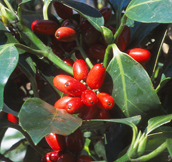
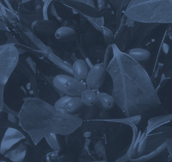 Aucuba japonica Cornaceae
Aucuba japonica Cornaceae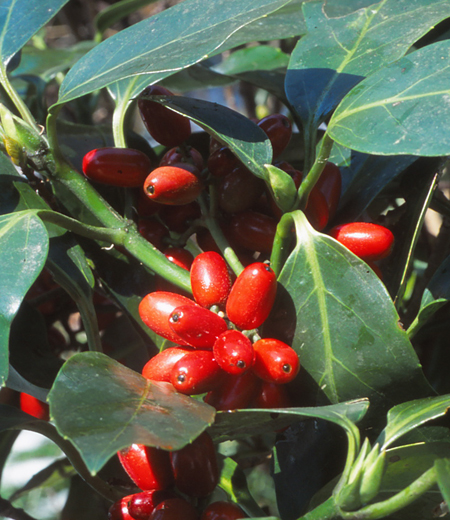 They are evergreen shrubs that ordinarily grow wild under the forests in the countryside. Cortex of young trees is shiny green color with thin gray-brown stripes and horizontally long lenticels. When grown adult trees, they are vertically split shallow and turn to gray-brown. As red matured seeds remain on the tree to pass the winter till next spring, they are popular as an ornamental garden tree. On the contrary, the seeds remain white color, they are called ‘Aucuba japonica Thunb. f. viridiflora Makino’, which was discovered at Mt. Takao for the first time and given this name in 1908. The leaves are wide elliptically-shaped about 8 to 20 cm long with the sharp top as well as with sawtooth (Kyoshi: tooth-like rough part like a saw at the root of a leaf) at the edge. The blossom seasons are about March to May and a dioecious plant (Shiyuuisyu). Numerous small purple-tingled flowers shoot at the inflorescence (Kajo: stalk blooming flowers) sprouting from the limb of the branch that extended the previous year. The seeds are long elliptically-shaped about 2 cm long, which get matured in December to May.
They are evergreen shrubs that ordinarily grow wild under the forests in the countryside. Cortex of young trees is shiny green color with thin gray-brown stripes and horizontally long lenticels. When grown adult trees, they are vertically split shallow and turn to gray-brown. As red matured seeds remain on the tree to pass the winter till next spring, they are popular as an ornamental garden tree. On the contrary, the seeds remain white color, they are called ‘Aucuba japonica Thunb. f. viridiflora Makino’, which was discovered at Mt. Takao for the first time and given this name in 1908. The leaves are wide elliptically-shaped about 8 to 20 cm long with the sharp top as well as with sawtooth (Kyoshi: tooth-like rough part like a saw at the root of a leaf) at the edge. The blossom seasons are about March to May and a dioecious plant (Shiyuuisyu). Numerous small purple-tingled flowers shoot at the inflorescence (Kajo: stalk blooming flowers) sprouting from the limb of the branch that extended the previous year. The seeds are long elliptically-shaped about 2 cm long, which get matured in December to May.
●Height about 2 and 3 m
●Place Trail 1 to 6, Mt.Inari, Oku-Takao -
Helwingia japonica Cornaceae
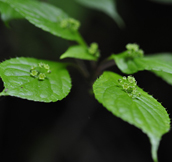
 Helwingia japonica Cornaceae
Helwingia japonica Cornaceae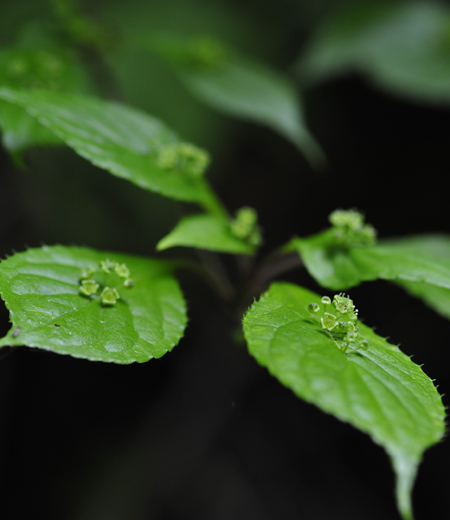 They are a deciduous shrub that grows wild at such humid places as in the pool of the forests along the mountain streams in the mountain area. The trunk grows together in cluster and is branched so often. Cortex of the young trees is smooth feeling to touch and shiny green color, while once grown ole trees turn into dark bistered. The characteristic is a small flower bloom in the middle of the leaf and people have used this appearance to resemble the one of a raft that looks like a leaf with a flower on it. This is how they are named. The leaves are wide elliptically-shaped about 6 to 12 cm long with thin and long sawtooth (Kyoshi: tooth-like rough part like a saw at the root of a leaf) at the edge. The blossom seasons are about May to June and hermaphroditism plant (Shiyuudousyu). On the main vein of the surface of the leaf, 1 female flower and several of male flowers gather to sprout. The flowers are pale green, about 5 mm long in diameter. The seeds are a spherical shape about 0.7 to 1 cm in diameter, and get matured to black-purple in August to October. The seeds taste sweet and young leaves are edible as Tempura and boiled leaves dish (Ohitashi).
They are a deciduous shrub that grows wild at such humid places as in the pool of the forests along the mountain streams in the mountain area. The trunk grows together in cluster and is branched so often. Cortex of the young trees is smooth feeling to touch and shiny green color, while once grown ole trees turn into dark bistered. The characteristic is a small flower bloom in the middle of the leaf and people have used this appearance to resemble the one of a raft that looks like a leaf with a flower on it. This is how they are named. The leaves are wide elliptically-shaped about 6 to 12 cm long with thin and long sawtooth (Kyoshi: tooth-like rough part like a saw at the root of a leaf) at the edge. The blossom seasons are about May to June and hermaphroditism plant (Shiyuudousyu). On the main vein of the surface of the leaf, 1 female flower and several of male flowers gather to sprout. The flowers are pale green, about 5 mm long in diameter. The seeds are a spherical shape about 0.7 to 1 cm in diameter, and get matured to black-purple in August to October. The seeds taste sweet and young leaves are edible as Tempura and boiled leaves dish (Ohitashi).
●Height about 1 to 3 m
●Place Trail 4, Trail 6, Ura-Takao -
Cornus controversa Cornaceae
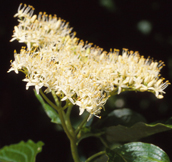
 Cornus controversa Cornaceae
Cornus controversa Cornaceae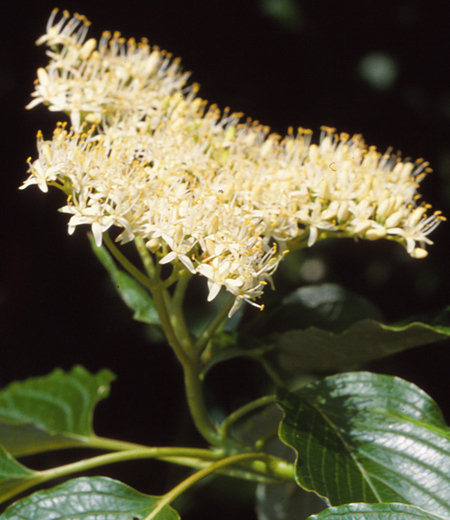 They are a deciduous tall tree that ordinarily grows wild in the mountain areas. They prefer growing at the very humid places along the mountain streams. The trunk grows to be 40 to 50 cm wide. Their characteristic is that they spread the branches like fan shape and that the layer of braches develops to be piled up several steps, which result in forming of a tree. Cortex is grayish black with vertically shallow stripe shape vallecula. The wood is white and utilized for materials to make folk crafts such as Kokeshi (wooden doll). The name ‘Mizuki’ derives from the facts that they are so sapful that when people break the branches early spring especially, the sap trickles. The leaves are wide elliptically-shaped about 6 to 15 cm long, which come together to grow in cluster at the limb of the branch. The leaves are shiny and the back is white like coating with flour, and bear dense trichome. The blossom seasons are about May to June, Small white flowers about 7 mm in diameter shoot in cluster at inflorescence (Kajo: stalk blooming flowers) sprouting from the limb of the branch. The seeds are a spherical shape about 7 mm in diameter, which get matured to black-purple in June to October.
They are a deciduous tall tree that ordinarily grows wild in the mountain areas. They prefer growing at the very humid places along the mountain streams. The trunk grows to be 40 to 50 cm wide. Their characteristic is that they spread the branches like fan shape and that the layer of braches develops to be piled up several steps, which result in forming of a tree. Cortex is grayish black with vertically shallow stripe shape vallecula. The wood is white and utilized for materials to make folk crafts such as Kokeshi (wooden doll). The name ‘Mizuki’ derives from the facts that they are so sapful that when people break the branches early spring especially, the sap trickles. The leaves are wide elliptically-shaped about 6 to 15 cm long, which come together to grow in cluster at the limb of the branch. The leaves are shiny and the back is white like coating with flour, and bear dense trichome. The blossom seasons are about May to June, Small white flowers about 7 mm in diameter shoot in cluster at inflorescence (Kajo: stalk blooming flowers) sprouting from the limb of the branch. The seeds are a spherical shape about 7 mm in diameter, which get matured to black-purple in June to October.
●Height about 10 to 20 m
●Place Trail 1 and 2,Trail 4, Trail 6, Mt.Inari, Ura-Takao -
Cornus macrophylla Cornaceae
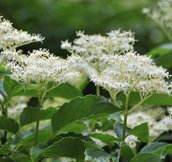
 Cornus macrophylla Cornaceae
Cornus macrophylla Cornaceae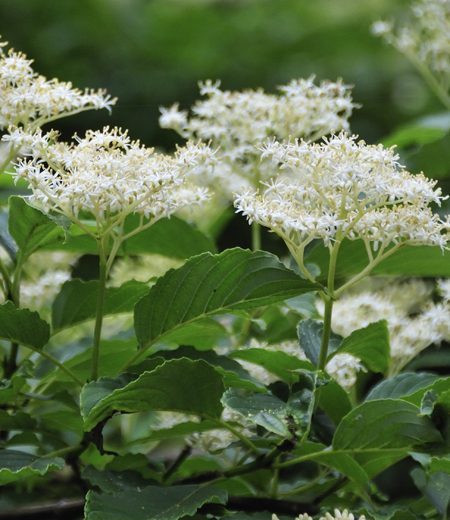 Deciduous small trees found in wet slopes and valleys in mountains. Barks are dark grayish green and young trees have vertical stripes. The ones on adult trees crack shallowly and trunk becomes 30 cm width. The Japanese name Kumano-mizuki was named because many of this plant grow in Kumano area in Mie-prefecture and this plant is in a cornaceae family (Mizuki in Japanese). The entire plant is similar to cornel but this plant have skinnier leaves and bloom one month later than others in a cornaceae family, around June to July. Leaves are 6 to 15 cm long, 3 to 7 cm width, elongated oval-shaped and many are near tips of stems. Have pointed tip with white short hair. Bloom 7 to 8 mm in diameter yellow-white flowers densely on inflorescence. After flowering, bear 5 mm in diameter andspherical shaped fruits. Turn black-purple as they ripen from July to October.
Deciduous small trees found in wet slopes and valleys in mountains. Barks are dark grayish green and young trees have vertical stripes. The ones on adult trees crack shallowly and trunk becomes 30 cm width. The Japanese name Kumano-mizuki was named because many of this plant grow in Kumano area in Mie-prefecture and this plant is in a cornaceae family (Mizuki in Japanese). The entire plant is similar to cornel but this plant have skinnier leaves and bloom one month later than others in a cornaceae family, around June to July. Leaves are 6 to 15 cm long, 3 to 7 cm width, elongated oval-shaped and many are near tips of stems. Have pointed tip with white short hair. Bloom 7 to 8 mm in diameter yellow-white flowers densely on inflorescence. After flowering, bear 5 mm in diameter andspherical shaped fruits. Turn black-purple as they ripen from July to October.
●Height about 8 to 12 m
●Place Trail 1, Trail 5, Mt. Inari -
Cornus kousa Cornaceae
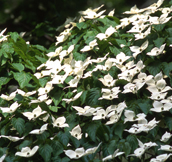
 Cornus kousa Cornaceae
Cornus kousa Cornaceae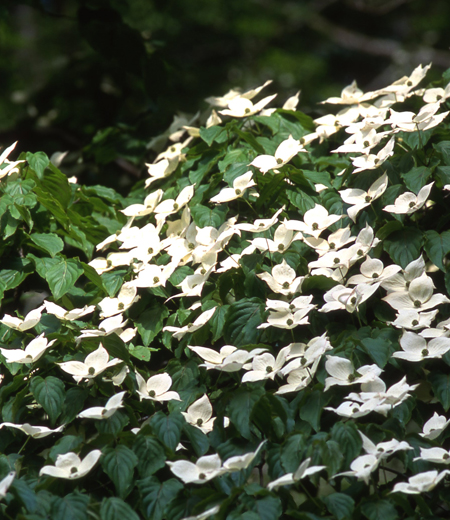 Deciduous small trees found on wet areas in forests and grasslands in mountains. Barks on young trees are gray or brown and smooth. It peels irregularly with age and become patched patterns on aged tree. Leaves are 4 to 12 cm long, wide egg-shaped and opposite on tips of stems. Tips are pointed and leaf veins runs on the back. Turn red in autumn. The blooming season is from June to July. Twenty to thirty small flowers create spherical inflorescence with four white involucral bracts (covers the base of flowers, transformed parts from leaves) open like petals. Japanese name Yama-boushi was named because the shape of flowers resembling preacher with white hat on. After flowering, bear 1 to 1.5 cm in diameter spherical fruits. Turn to red from September to October and fruits are edible.
Deciduous small trees found on wet areas in forests and grasslands in mountains. Barks on young trees are gray or brown and smooth. It peels irregularly with age and become patched patterns on aged tree. Leaves are 4 to 12 cm long, wide egg-shaped and opposite on tips of stems. Tips are pointed and leaf veins runs on the back. Turn red in autumn. The blooming season is from June to July. Twenty to thirty small flowers create spherical inflorescence with four white involucral bracts (covers the base of flowers, transformed parts from leaves) open like petals. Japanese name Yama-boushi was named because the shape of flowers resembling preacher with white hat on. After flowering, bear 1 to 1.5 cm in diameter spherical fruits. Turn to red from September to October and fruits are edible.
●Height about 5 to 10 m
●Place Trail 1, Mt.Inari -
Rhododendoron dilatatum Ericaceae
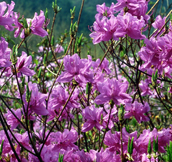
 Rhododendoron dilatatum Ericaceae
Rhododendoron dilatatum Ericaceae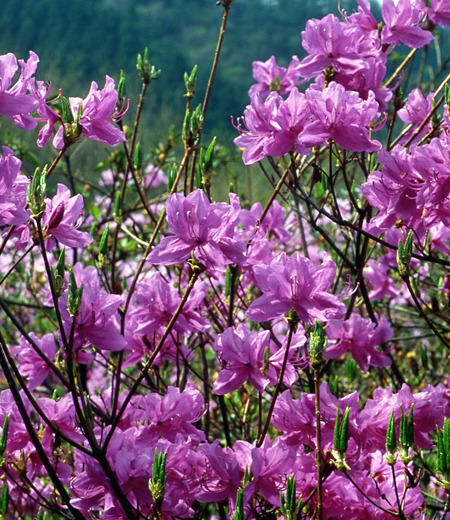 They are a deciduous shrub that grows wild in the forests and on the rocks around the hilly areas to the mountain district. 3 leaves verticillate on the limb, which gives them the name. Cortex is tinged with grayish black and smooth feeling to touch. Young branches are reddish violet and bear trichome at first, but later trichome disappears. The leaves are roundish lozenge-shaped, about 4 to 7 cm long, about 2.5 to 5 cm wide with the sharp top and the edge a little bit dulating. Young leaves are rolled inward bearing tentacle on both sides and viscous, but adult leaves bear no tentacle. The leaves turn into red in autumn. The blossom seasons are about March to April, when their vivid red-purple flowers blossom before the other plants sprout. This makes them stand out very much. The flowers are about 3 to 4 cm in diameter with the flower split into 5 to be open. The seeds are terete about 0.7 to 1.2 cm long and when they get matured in July to September, they are split into 5 to spread the seedlings out.
They are a deciduous shrub that grows wild in the forests and on the rocks around the hilly areas to the mountain district. 3 leaves verticillate on the limb, which gives them the name. Cortex is tinged with grayish black and smooth feeling to touch. Young branches are reddish violet and bear trichome at first, but later trichome disappears. The leaves are roundish lozenge-shaped, about 4 to 7 cm long, about 2.5 to 5 cm wide with the sharp top and the edge a little bit dulating. Young leaves are rolled inward bearing tentacle on both sides and viscous, but adult leaves bear no tentacle. The leaves turn into red in autumn. The blossom seasons are about March to April, when their vivid red-purple flowers blossom before the other plants sprout. This makes them stand out very much. The flowers are about 3 to 4 cm in diameter with the flower split into 5 to be open. The seeds are terete about 0.7 to 1.2 cm long and when they get matured in July to September, they are split into 5 to spread the seedlings out.
●Height about 2 to 3m
●Place Oku-Takao -
Rhododendron kaempferi Ericaceae
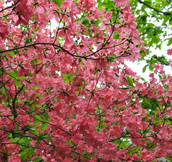
 Rhododendron kaempferi Ericaceae
Rhododendron kaempferi Ericaceae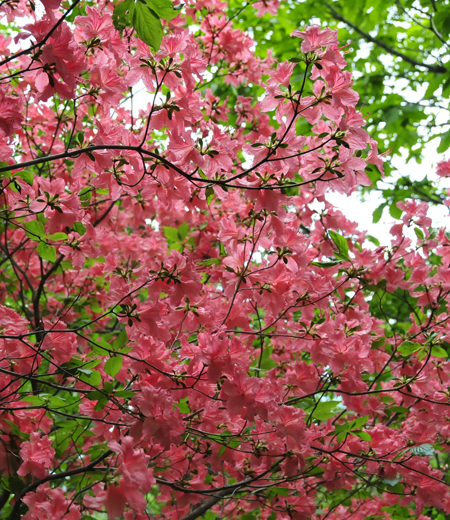 They are a semi-evergreen Japanese shrub that grows wild in the pool in the forests around hilly district and low mountain areas. The leaves grown in spring fall in autumn, the leaves grown in summer pass the winter. Cortex is tinged with grayish black and smooth feeling to touch, but as for adult trees cortex is minutely peeled off on the surface. The leaves are elliptically-shaped about 3 to 5 cm long and about 1 to 3 cm wide. The characteristic is thin and bear rough blistered trichome. Summer leaves are smaller than spring leaves, about 1 to 2 cm long. The blossom seasons are about April to June with 1 to 3 of vermilion or red flowers on the climbs. The flowers are about 4 to 5 cm in diameter and the flower petals are split into 5 to be open with patterns of dark colors inside. The flowers that bear white ones are called ‘Rhododendron kaempferi var. kaempferi f. album’. The seeds are elliptically-shaped about 8 to 13 mm long with brown trichome. They get matured in August to October to be split out.
They are a semi-evergreen Japanese shrub that grows wild in the pool in the forests around hilly district and low mountain areas. The leaves grown in spring fall in autumn, the leaves grown in summer pass the winter. Cortex is tinged with grayish black and smooth feeling to touch, but as for adult trees cortex is minutely peeled off on the surface. The leaves are elliptically-shaped about 3 to 5 cm long and about 1 to 3 cm wide. The characteristic is thin and bear rough blistered trichome. Summer leaves are smaller than spring leaves, about 1 to 2 cm long. The blossom seasons are about April to June with 1 to 3 of vermilion or red flowers on the climbs. The flowers are about 4 to 5 cm in diameter and the flower petals are split into 5 to be open with patterns of dark colors inside. The flowers that bear white ones are called ‘Rhododendron kaempferi var. kaempferi f. album’. The seeds are elliptically-shaped about 8 to 13 mm long with brown trichome. They get matured in August to October to be split out.
●Height about 1 to 4 m
●Place Oku-Takao -
Fraxinus sieboldiana Oleaceae
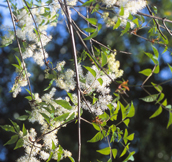
 Fraxinus sieboldiana Oleaceae
Fraxinus sieboldiana Oleaceae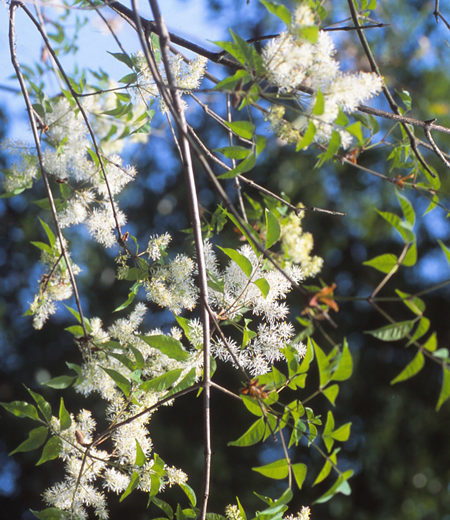 Deciduous small trees found in dry forest edges in mountains. Barks are dark gray and smooth. Young branches are green with hair and turn to gray on the following year. Leaves are 10 to 20 cm long five to seven leaflets are in whorls. Leaflets are 5 to 12 cm long, wide egg-shaped with wavy edges. The blooming season is from April to May, and has male and female flowers. Bloom white small flowers on cylindrical inflorescence grow from petioles or branches grow in a year. Flowers are lobed in four and 6 to 7 mm long. After flowering, bears 3 cm long, 4 to 5 mm width, red and flattened fruits. One seed is in one fruit.
Deciduous small trees found in dry forest edges in mountains. Barks are dark gray and smooth. Young branches are green with hair and turn to gray on the following year. Leaves are 10 to 20 cm long five to seven leaflets are in whorls. Leaflets are 5 to 12 cm long, wide egg-shaped with wavy edges. The blooming season is from April to May, and has male and female flowers. Bloom white small flowers on cylindrical inflorescence grow from petioles or branches grow in a year. Flowers are lobed in four and 6 to 7 mm long. After flowering, bears 3 cm long, 4 to 5 mm width, red and flattened fruits. One seed is in one fruit.
●Height about 5 to 15 m
●Place Kita-Takao -
Trachelospermum asiaticum (Japanese star jasmine) Apocynaceae
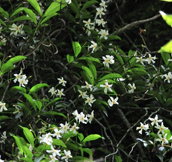
 Trachelospermum asiaticum (Japanese star jasmine) Apocynaceae
Trachelospermum asiaticum (Japanese star jasmine) Apocynaceae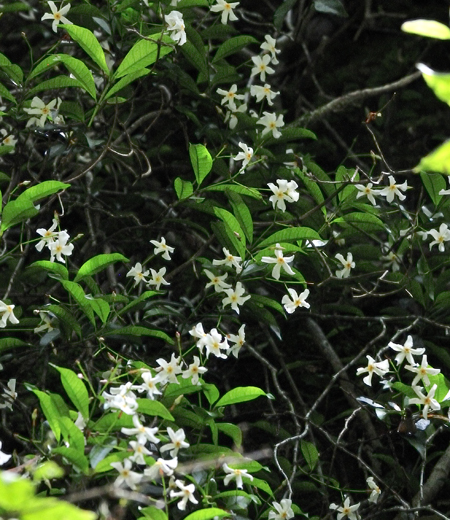 Evergreen vines found in forests in mountains.
Evergreen vines found in forests in mountains.
Stems grow long by extending clinging root (roots that grow from stem cling to adjacent plants to support the growth of whole plant) and twine around adjacent trees or rocks.
Thick stem grow up to 8 cm in diameter.
Leaves are 3 to 7 cm long, oval-shaped, have leathery texture with shiny surface. Some flowers bloom on tips of branches and petioles on upper part of plants.
Flowers are 3 to 5 cm in diameter and have beautiful perfume.
Tips of tubular flower is lobed in five and petals are twisting.
The color of flowers is white at first but gradually turn yellowish. After flowering, bear 15~25 cm long elongated fruits.
Ripe as it tip drops to create an arch shape and split open.
Seeds have white hair and flown by the wind.
The Japanese name Teika-kazura was named after Teika Fujiwara, a Japanese poet, critic, calligrapher, novelist, anthologist, scribe, and scholar of the late Heian and early Kamakura periods.
●Season May to June
●Height Vines
●Place Trail 1 to 4, Oku-Takao -
Callicarpa japonica Verbenaceae
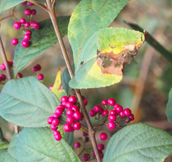
 Callicarpa japonica Verbenaceae
Callicarpa japonica Verbenaceae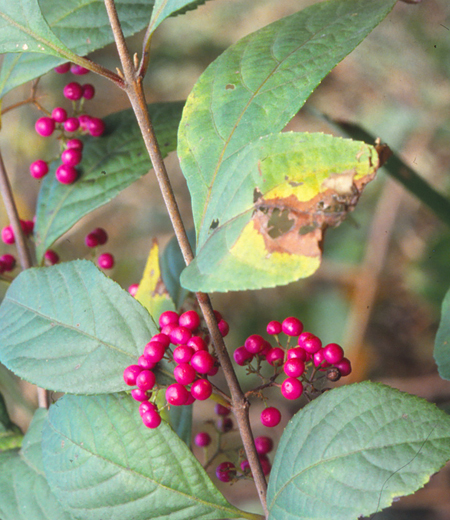 They are a deciduous shrub that grows wild in the pool at the plain field and in the forests at the mountain areas. Cortex is tinged with pale gray and smooth feeling to touch, but the one of old trees are vertically split and peeled off. As they bear burnished purple beautiful seeds, they are planted as garden trees so often, which is the reason for their name. In some cases, there are different group of Callicarpa dichotoma (Lour.) K.Koch (Komurasaki) among the gardening trees that are distributed. The leaves are elliptically-shaped, about 6 to 13 cm long, with the sharp top, and have sparse SENTEN tinged with yellow with a sawtooth (sawtooth: Kyoshi, serrated edges like a saw serrated edges at the tip of a leaf). The blossom seasons are about June to August and from the side of the leaf does inflorescence (Kajo: stalk blooming flowers) sprout out with many pale purple flowers. The flowers are about 4 mm long in diameter, with the upper portion split into 4 to be open flat as well as 4 male stamen outshoot long. The seeds are a spherical shape about 3 to 4 mm in diameters, and get matured in autumn.
They are a deciduous shrub that grows wild in the pool at the plain field and in the forests at the mountain areas. Cortex is tinged with pale gray and smooth feeling to touch, but the one of old trees are vertically split and peeled off. As they bear burnished purple beautiful seeds, they are planted as garden trees so often, which is the reason for their name. In some cases, there are different group of Callicarpa dichotoma (Lour.) K.Koch (Komurasaki) among the gardening trees that are distributed. The leaves are elliptically-shaped, about 6 to 13 cm long, with the sharp top, and have sparse SENTEN tinged with yellow with a sawtooth (sawtooth: Kyoshi, serrated edges like a saw serrated edges at the tip of a leaf). The blossom seasons are about June to August and from the side of the leaf does inflorescence (Kajo: stalk blooming flowers) sprout out with many pale purple flowers. The flowers are about 4 mm long in diameter, with the upper portion split into 4 to be open flat as well as 4 male stamen outshoot long. The seeds are a spherical shape about 3 to 4 mm in diameters, and get matured in autumn.
●Height about 2 to 3 m
●Place Mt.Inariy, Oku-Takao -
Lonicer gracilipes var. glabra Caprifoliaceae
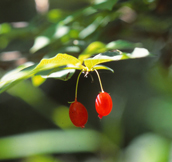
 Lonicer gracilipes var. glabra Caprifoliaceae
Lonicer gracilipes var. glabra Caprifoliaceae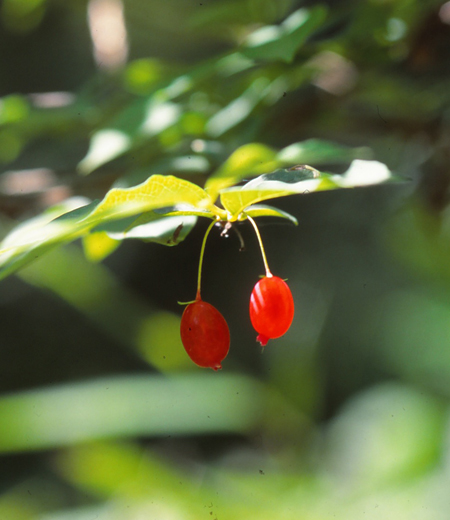 They are a deciduous shrub that grows wild in the pool and in the forests in the sunny forests at the mountain areas. Their branches often diverge to form dense beds. Cortex is tinged with blackish brown and the one of old trees is vertically split and peeled off, while young branch is tinged with a little bit red. The leaves are wide egged-shaped about 3 to 6 cm long, about 2 to 4 cm wide, and sprout sideways. The back of the leaves bear sparse trichome tinged with white color. The blossom seasons are about April to May. Inflorescence (Kajo: stalk blooming flowers) sprouts out, about 1 to 2 cm, on the branch that extend that year, and then dangle 1to 2 of pale showy pink flowers downwards. The flowers are thin, cylindrical shaped like a bugle, about 1 to 1.5 cm long with the top split into 5 to be open flat as well as male stamen outshoot long. The seeds are elliptically-shaped about 1 to 1.5 cm long, and get matured to red in June, sweet and edible.
They are a deciduous shrub that grows wild in the pool and in the forests in the sunny forests at the mountain areas. Their branches often diverge to form dense beds. Cortex is tinged with blackish brown and the one of old trees is vertically split and peeled off, while young branch is tinged with a little bit red. The leaves are wide egged-shaped about 3 to 6 cm long, about 2 to 4 cm wide, and sprout sideways. The back of the leaves bear sparse trichome tinged with white color. The blossom seasons are about April to May. Inflorescence (Kajo: stalk blooming flowers) sprouts out, about 1 to 2 cm, on the branch that extend that year, and then dangle 1to 2 of pale showy pink flowers downwards. The flowers are thin, cylindrical shaped like a bugle, about 1 to 1.5 cm long with the top split into 5 to be open flat as well as male stamen outshoot long. The seeds are elliptically-shaped about 1 to 1.5 cm long, and get matured to red in June, sweet and edible.
●Height about 2 to 3 m
●Place Trail 1, Mt.Inari -
Abelia spathulata Caprifoliaceae
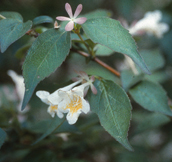
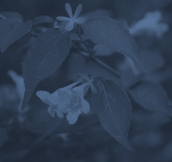 Abelia spathulata Caprifoliaceae
Abelia spathulata Caprifoliaceae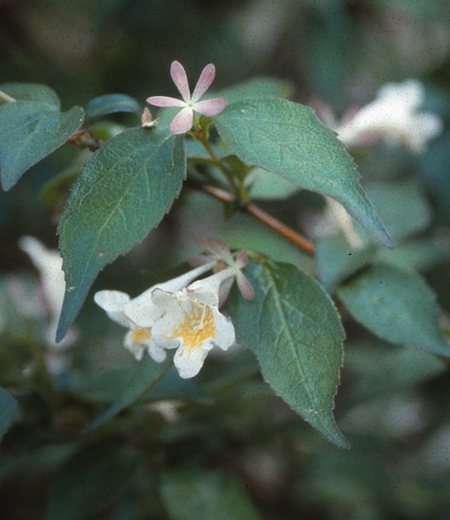 They are a deciduous shrub that grows wild at such sunny places as in the pool and in the forests at the mountain areas. Their thin branches frequently diverge to form dense beds. Cortex of young trees is tinged with reddish brown, while the one of old trees turns into gray-brown, irregularly cracks to be peeled off. The leaves are wide egged-shaped about 2 to 5 cm long, with a sawtooth (sawtooth: Kyoshi, serrated edges like a saw serrated edges at the tip of a leaf) at the edge. The blossom seasons are about May to June, and 2 of pale yellow flowers spout at the short top on the branch that extends that year. The flowers are hanging bell-shaped and swollen in the middle, about 2 to 2.7 cm long with the top split into 5 and orange-tinged patterns inside. The seeds are rod-shaped about 8 to 14 mm long with 5 calyxes remaining like airscrew. This appearance is compared as a rotor blade of Hanetsuki, which is the reason for their name. The seeds get matured in September to November, and then are carried away by wind.
They are a deciduous shrub that grows wild at such sunny places as in the pool and in the forests at the mountain areas. Their thin branches frequently diverge to form dense beds. Cortex of young trees is tinged with reddish brown, while the one of old trees turns into gray-brown, irregularly cracks to be peeled off. The leaves are wide egged-shaped about 2 to 5 cm long, with a sawtooth (sawtooth: Kyoshi, serrated edges like a saw serrated edges at the tip of a leaf) at the edge. The blossom seasons are about May to June, and 2 of pale yellow flowers spout at the short top on the branch that extends that year. The flowers are hanging bell-shaped and swollen in the middle, about 2 to 2.7 cm long with the top split into 5 and orange-tinged patterns inside. The seeds are rod-shaped about 8 to 14 mm long with 5 calyxes remaining like airscrew. This appearance is compared as a rotor blade of Hanetsuki, which is the reason for their name. The seeds get matured in September to November, and then are carried away by wind.
●Height about 1.5 to 2 m
●Place Trail 5, Oku-Takao -
Viburnum plicatum var. tomentosum Caprifoliaceae
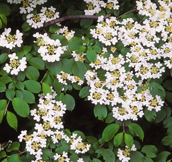
 Viburnum plicatum var. tomentosum Caprifoliaceae
Viburnum plicatum var. tomentosum Caprifoliaceae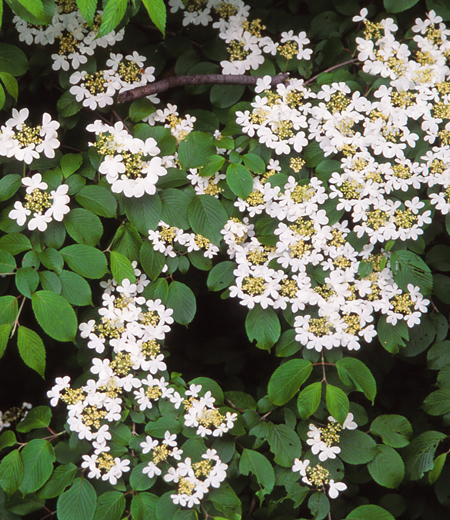 Deciduous small trees (less than 10 m tall tree that sheds its leaves once in a year) found in wet forest edges and waterside.Branches extend horizontally and young leaves are brown with hair. Barks are grayish-black, smooth and have irregularly placed lenticels (an opening that allows gases to be exchanged between air and the inner tissues of a plant). Leaves are 5 to 12 cm long and wide oval shape with pointed tip.Have hair on leaf veins on the back and toothed margins (edges of leaves are like a teeth of saw). Blooming season is from May to June, bloom 5 to 6 mm in diameter cream colored bisexual flowers (stamen and pistil coexist in one flower) surrounded by 3 to 4 cm in diameter white ornamental flowers (surround inflorescence have no stamen or pistils) on inflorescence (stem with flowers) grow from branches. This looks like thread ball, hence the Japanese name Yabu-demari literally means thread ball in shrubs. Fruits are 5 to 7 mm long and oval-shaped and after turning red from August to October, turn black as they ripen.
Deciduous small trees (less than 10 m tall tree that sheds its leaves once in a year) found in wet forest edges and waterside.Branches extend horizontally and young leaves are brown with hair. Barks are grayish-black, smooth and have irregularly placed lenticels (an opening that allows gases to be exchanged between air and the inner tissues of a plant). Leaves are 5 to 12 cm long and wide oval shape with pointed tip.Have hair on leaf veins on the back and toothed margins (edges of leaves are like a teeth of saw). Blooming season is from May to June, bloom 5 to 6 mm in diameter cream colored bisexual flowers (stamen and pistil coexist in one flower) surrounded by 3 to 4 cm in diameter white ornamental flowers (surround inflorescence have no stamen or pistils) on inflorescence (stem with flowers) grow from branches. This looks like thread ball, hence the Japanese name Yabu-demari literally means thread ball in shrubs. Fruits are 5 to 7 mm long and oval-shaped and after turning red from August to October, turn black as they ripen.
●Height about 2 to 6m
●Place Kita-Takao -
Viburnum dilatatum Caprifoliaceae
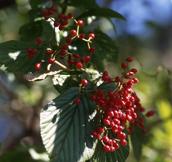
 Viburnum dilatatum Caprifoliaceae
Viburnum dilatatum Caprifoliaceae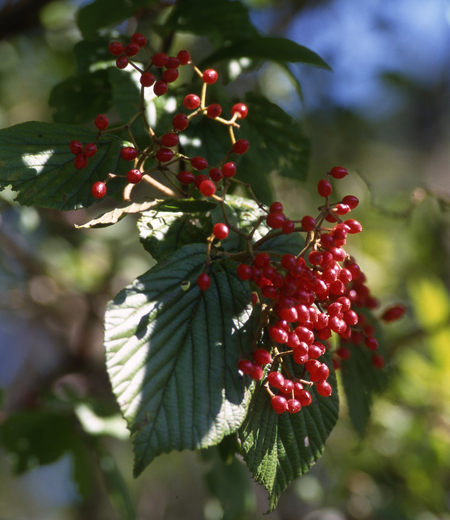 Deciduous shrubs found in sunny forest edge in mountains. Barks are gray-brown and smooth. Have lenticels (an opening that allows gases to be exchanged between air and the inner tissues of a plant) and fine splits are created as it grows. The stems become up to about 4 cm in diameter. Leaves are 6 to 14 cm long, 3 to 13 cm width, round-shaped with sharp tip with toothed margins (edges of leaves are like a teeth of saw). Have hair on both sides and distinct leaf glands (small glands to release secretion). Blooming season is from May to June. Bloom small white flowers in 6 to 10 cm in diameter inflorescence (stem with flowers). Flowers are 5 to 8 mm in diameter, lobed in five and petals flat with long stamens protruded. Fruits are oval-shaped, about 6 mm long and turn red from September to November. In winter, turns powdery white, become sweet and edible
Deciduous shrubs found in sunny forest edge in mountains. Barks are gray-brown and smooth. Have lenticels (an opening that allows gases to be exchanged between air and the inner tissues of a plant) and fine splits are created as it grows. The stems become up to about 4 cm in diameter. Leaves are 6 to 14 cm long, 3 to 13 cm width, round-shaped with sharp tip with toothed margins (edges of leaves are like a teeth of saw). Have hair on both sides and distinct leaf glands (small glands to release secretion). Blooming season is from May to June. Bloom small white flowers in 6 to 10 cm in diameter inflorescence (stem with flowers). Flowers are 5 to 8 mm in diameter, lobed in five and petals flat with long stamens protruded. Fruits are oval-shaped, about 6 mm long and turn red from September to November. In winter, turns powdery white, become sweet and edible
●Height about 2 to 4 m
●Place Trail 4, Mt. Inari, Oku-Takao -
Lonicer japonica Caprifoliaceae
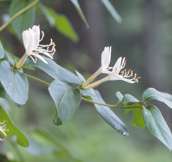
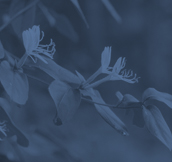 Lonicer japonica Caprifoliaceae
Lonicer japonica Caprifoliaceae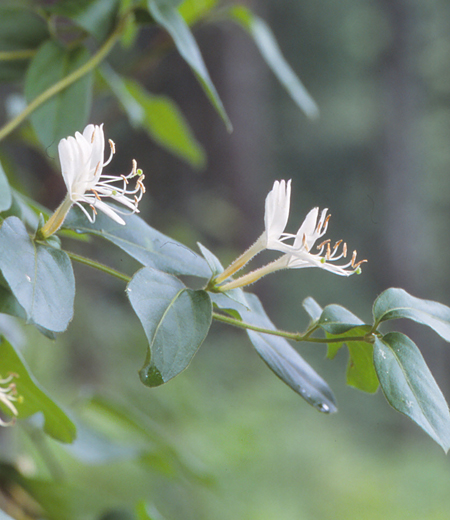 Semi-deciduous woody vines found at roadside in mountains. Stems grow long and have many branches. Barks are grayish-brown, split vertically with age and have rough hair on young branches. The Japanese name Sui-kazura literally meaning suck vines was named because their sweet nectar was sucked and used instead of sugar. Leaves are 3 to 7 cm long, 1 to 3 cm width and oval-shaped with round tip. Have hair densely on the back and spent winter with them curled inward. The blooming season is from May to June, bloom two sweet perfumed flowers at the base of petioles. Flowers are 3 to 4 cm tubular-shaped and tips curl up and down. The upper petals are lobed in four and have white to reddish but gradually turns to yellow. Fruits are 5 to 6 mm in diameter, turn black as they ripen from September to December.
Semi-deciduous woody vines found at roadside in mountains. Stems grow long and have many branches. Barks are grayish-brown, split vertically with age and have rough hair on young branches. The Japanese name Sui-kazura literally meaning suck vines was named because their sweet nectar was sucked and used instead of sugar. Leaves are 3 to 7 cm long, 1 to 3 cm width and oval-shaped with round tip. Have hair densely on the back and spent winter with them curled inward. The blooming season is from May to June, bloom two sweet perfumed flowers at the base of petioles. Flowers are 3 to 4 cm tubular-shaped and tips curl up and down. The upper petals are lobed in four and have white to reddish but gradually turns to yellow. Fruits are 5 to 6 mm in diameter, turn black as they ripen from September to December.
●Height Vines
●Place Oku-Takao -
Pertya scandens Compositae
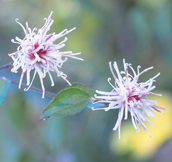
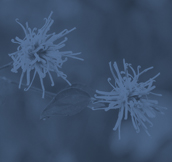 Pertya scandens Compositae
Pertya scandens Compositae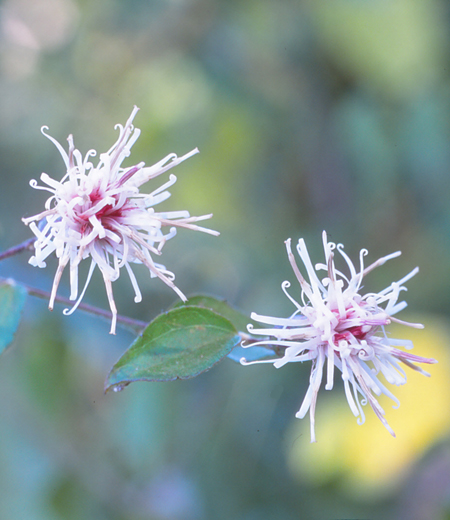 They are a small genus of low deciduous shrubs that often grows in the sunny arid forests in the mountain areas, and that shoots many branches at the root to grow close together. The branch is thin and tinged with gray-brown with short trichome. A long ago, people resident at Mt. Kouya-san used to utilize this tree to bundle to make a broom which replaces bamboo besom (Take-bouki). This is how they are named ‘Pertya scandens’ (Kouya-bouki). The blossom seasons are about September to November, and 1 flower blooms at the top of each branch that extends newly that year. The flower consists of small 13 flowers as one and about 1.5 cm long. The top of the flowers are deeply split into 5 and rolled backward. 1-year old leaves are egged-shaped about 2 to 5 cm long, and grow alternative on the branch. 3 to 4 of thin and long leaves verticillate at each knot on the branch that extended the previous year. Both leaves bear short trichome with a shallow sawtooth (sawtooth: Kyoshi, serrated edges like a saw serrated edges at the tip of a leaf).
They are a small genus of low deciduous shrubs that often grows in the sunny arid forests in the mountain areas, and that shoots many branches at the root to grow close together. The branch is thin and tinged with gray-brown with short trichome. A long ago, people resident at Mt. Kouya-san used to utilize this tree to bundle to make a broom which replaces bamboo besom (Take-bouki). This is how they are named ‘Pertya scandens’ (Kouya-bouki). The blossom seasons are about September to November, and 1 flower blooms at the top of each branch that extends newly that year. The flower consists of small 13 flowers as one and about 1.5 cm long. The top of the flowers are deeply split into 5 and rolled backward. 1-year old leaves are egged-shaped about 2 to 5 cm long, and grow alternative on the branch. 3 to 4 of thin and long leaves verticillate at each knot on the branch that extended the previous year. Both leaves bear short trichome with a shallow sawtooth (sawtooth: Kyoshi, serrated edges like a saw serrated edges at the tip of a leaf).
●Height about 60 cm to 1 m
●Place Trail 5, Mt.Inari, Oku-Takao -
Equisetum arvense (Field Horsetail) Equisetaceae
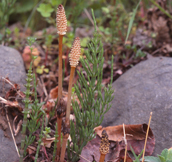
 Equisetum arvense (Field Horsetail) Equisetaceae
Equisetum arvense (Field Horsetail) Equisetaceae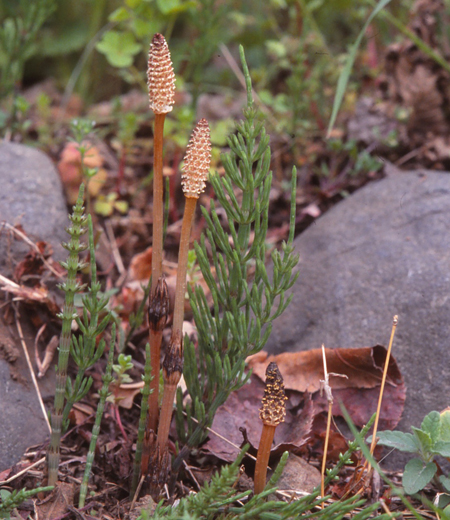 Fern plants found in sunny riverbanks and grass fields. Often seen them in clusters as they grow with spores as well as underground stems. Fertile shoots and plants are both called as field (common) horsetail. Fertile stems are light brown and appear on the ground around March. Have tiers of spore cases surrounding the tip of plant. When fertile stems wilted, field horsetail starts to grow. Field horsetail is called sterile stem which stem and leaves are united and create nutrient element through photonic synthesis. It is green and reminds us of soft ceder leaves as the Japanese name Sugina literally meaning ceder plant. Fertile shoots before fertile spore open can be eaten deep flied or marinated
Fern plants found in sunny riverbanks and grass fields. Often seen them in clusters as they grow with spores as well as underground stems. Fertile shoots and plants are both called as field (common) horsetail. Fertile stems are light brown and appear on the ground around March. Have tiers of spore cases surrounding the tip of plant. When fertile stems wilted, field horsetail starts to grow. Field horsetail is called sterile stem which stem and leaves are united and create nutrient element through photonic synthesis. It is green and reminds us of soft ceder leaves as the Japanese name Sugina literally meaning ceder plant. Fertile shoots before fertile spore open can be eaten deep flied or marinated
●Season March to about September
●Height about10 to 15 cm (fertile stems), about 10 to 40 cm (Field Horsetail)
●Place Trail 1, Oku-Takao -
Botrychium japonicum Ophioglossaceae
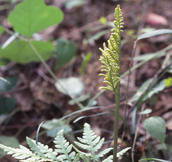
 Botrychium japonicum Ophioglossaceae
Botrychium japonicum Ophioglossaceae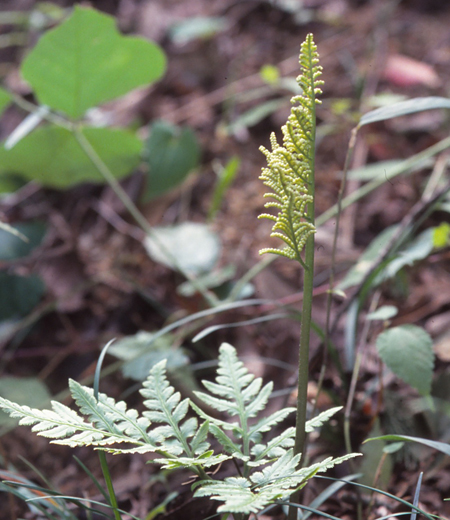 Winter green ferns (wilt in summer) found in forests or on rich soils from hills to mountains. Trophophyll (leaves for photonic synthesis) and some spore leaves (leaves with spores) grow from one petiole. Trophophyll is about 10 to 20 cm. Pinna (small leaves grow in clusters like feathers) is pointed with toothed margins (edges of leaves are like a teeth of saw). Texture is soft and color is green or brownish green. The lowest pinna is the largest and become smaller as it goes up. Similar plants are botrychium ternatum and botrychium nipponicum but this plant has pointed trophophyll and hair on stems, petioles and leaf axils. Spores are ripe during October to November.
Winter green ferns (wilt in summer) found in forests or on rich soils from hills to mountains. Trophophyll (leaves for photonic synthesis) and some spore leaves (leaves with spores) grow from one petiole. Trophophyll is about 10 to 20 cm. Pinna (small leaves grow in clusters like feathers) is pointed with toothed margins (edges of leaves are like a teeth of saw). Texture is soft and color is green or brownish green. The lowest pinna is the largest and become smaller as it goes up. Similar plants are botrychium ternatum and botrychium nipponicum but this plant has pointed trophophyll and hair on stems, petioles and leaf axils. Spores are ripe during October to November.
●Season October to about March
●Height about 30 to 50 cm
●Place Oku-Takao -
Osmunda japonica Osmundaceae
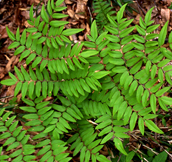
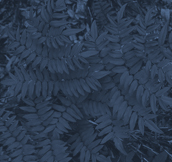 Osmunda japonica Osmundaceae
Osmunda japonica Osmundaceae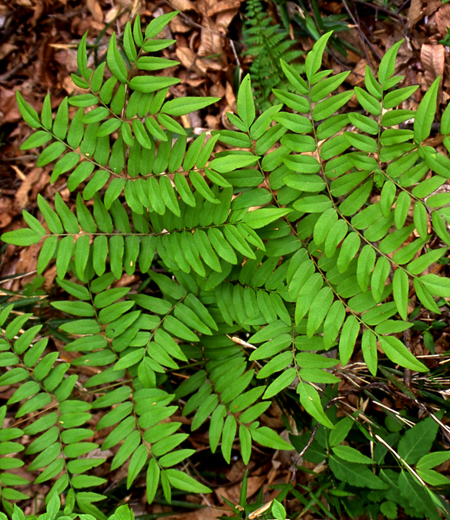 Summer green ferns (wilt in winter) found in forests and grasslands from hills to mountains. Prefer wet areas and often found near streams and ditches. Young leaves are create spiral shape and covered by hair, this resemble old coin called zenmaki and changed to the current Japanese name Zenmai. Flat spiral spring, zenmai-bane used in machines is named after this plant. It is one of the popular plants in wild plants to eat but young leaves of trophophyll (leaves for photonic synthesis) and spore leaves (leaves with spores) are too hard to eat. Trophophyll grow up to about 50 cm, yellow-green and soft with toothed margins (edges of leaves are like a teeth of saw). Parallel leaf veins become visible when looking at plants through the sun. Spore leaves are stick-shape and green become brown when ripen and wilt in early summer.
Summer green ferns (wilt in winter) found in forests and grasslands from hills to mountains. Prefer wet areas and often found near streams and ditches. Young leaves are create spiral shape and covered by hair, this resemble old coin called zenmaki and changed to the current Japanese name Zenmai. Flat spiral spring, zenmai-bane used in machines is named after this plant. It is one of the popular plants in wild plants to eat but young leaves of trophophyll (leaves for photonic synthesis) and spore leaves (leaves with spores) are too hard to eat. Trophophyll grow up to about 50 cm, yellow-green and soft with toothed margins (edges of leaves are like a teeth of saw). Parallel leaf veins become visible when looking at plants through the sun. Spore leaves are stick-shape and green become brown when ripen and wilt in early summer.
●Season April to about September
●Height about 50 cm to 1 m
●Place Ura-Takao, Oku-Takao -
Pteridium aquilinum var. latiusculum (Bracken) Dennstaedtiaceae
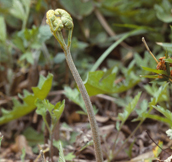
 Pteridium aquilinum var. latiusculum (Bracken) Dennstaedtiaceae
Pteridium aquilinum var. latiusculum (Bracken) Dennstaedtiaceae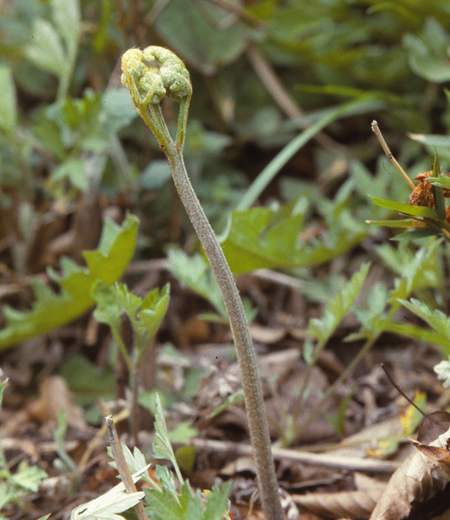 Summer green ferns (wilt in winter) found in sunny grasslands and residential area from hills to mountains. Rhizomes grow along the ground. Like osmunda japonica, spiral young leaves are edible but needs to be immersed in water to remove scums because they are toxic. Starch used for Japanese sweets are extracted from the rhizomes. Leaves are about 50 to 70 cm and deeply pinnate and pinna are even more pinnate like feathers. Pinna (small leaves grow in clusters like feathers) are wide open, create triangle or pentagon shape. Texture is hard and not shiny and has hair on the back. Have sorus with spore case (case to store spore) along edges on the back.
Summer green ferns (wilt in winter) found in sunny grasslands and residential area from hills to mountains. Rhizomes grow along the ground. Like osmunda japonica, spiral young leaves are edible but needs to be immersed in water to remove scums because they are toxic. Starch used for Japanese sweets are extracted from the rhizomes. Leaves are about 50 to 70 cm and deeply pinnate and pinna are even more pinnate like feathers. Pinna (small leaves grow in clusters like feathers) are wide open, create triangle or pentagon shape. Texture is hard and not shiny and has hair on the back. Have sorus with spore case (case to store spore) along edges on the back.
●Season April to about September
●Height about 1 to 2 m
●Place Oku-Takao -
Adiantum pedatum Adiantaceae
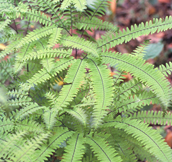
 Adiantum pedatum Adiantaceae
Adiantum pedatum Adiantaceae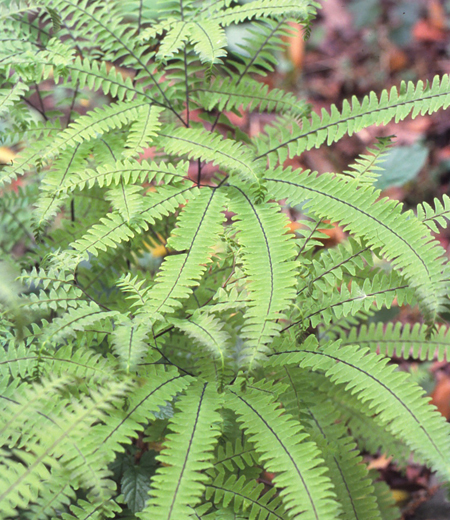 Summer green ferns (wilt in winter) found in cool areas including forest edges or cliffs on hills or mountains. One petiole divided into many branches and has many leaves resembling peacock open the tail, hence the Japanese name Kujyaku-sida literally meaning peacock ferns. Stems grow underground and have slight scales (scale-like shape parts found on stems and petioles in ferns). Petioles are thin and hard and red-purple. Leaves are about 15 to 25 cm long and width become up to about 30 cm. Is bright green and soft and have half-moon shaped sorus (spore case to store spores) along upper edges on the back. Sprout is light red and may appear as flowers when looking at this plant from the distance. Adiantum is often found at gardening stores but this plant is also sold.
Summer green ferns (wilt in winter) found in cool areas including forest edges or cliffs on hills or mountains. One petiole divided into many branches and has many leaves resembling peacock open the tail, hence the Japanese name Kujyaku-sida literally meaning peacock ferns. Stems grow underground and have slight scales (scale-like shape parts found on stems and petioles in ferns). Petioles are thin and hard and red-purple. Leaves are about 15 to 25 cm long and width become up to about 30 cm. Is bright green and soft and have half-moon shaped sorus (spore case to store spores) along upper edges on the back. Sprout is light red and may appear as flowers when looking at this plant from the distance. Adiantum is often found at gardening stores but this plant is also sold.
●Season May to about September
●Height about 30 to 60 cm
●Place Trail 6 -
Pteris cretica L Pteridaceae
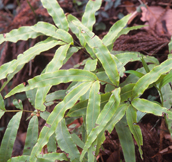
 Pteris cretica L Pteridaceae
Pteris cretica L Pteridaceae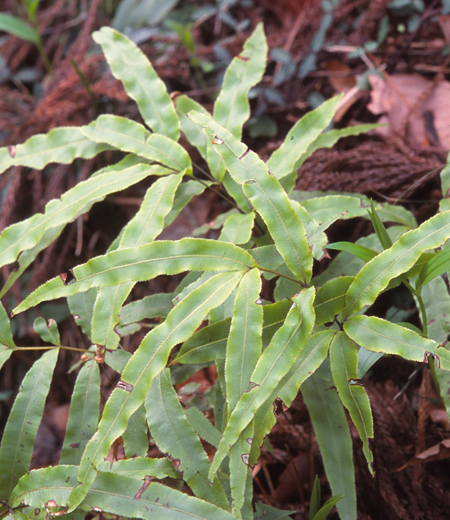 Evergreen ferns have green leaves throughout the year found in forests from hills to mountains. Have trophophyll and spore leaves (leaves with spores). The Japanese name Oobano-inomotoso literally meaning large leaves pteris multifida poir. because leaves are larger than pteris multifida poir. This plant does not have flat shaped protruded parts on leave axils. Petioles are brown at the base and have six to fourteen about 1.5 to 3 cm width elongated leaves and the entire length become about 20 to 60 cm. The leaves at the bottom are about 16 cm long. Petioles of trophophyll (leaves for photonic synthesis) have hair randomly, soft and wavy edges with toothed margins (edges of leaves are like a teeth of saw). Spore leaves (leaves with spores) grow upright from the plant and about 1 to 1.5 cm width and thinner than trophophyll with sorus (spore case to store spores) along edges of the back of leaves.
Evergreen ferns have green leaves throughout the year found in forests from hills to mountains. Have trophophyll and spore leaves (leaves with spores). The Japanese name Oobano-inomotoso literally meaning large leaves pteris multifida poir. because leaves are larger than pteris multifida poir. This plant does not have flat shaped protruded parts on leave axils. Petioles are brown at the base and have six to fourteen about 1.5 to 3 cm width elongated leaves and the entire length become about 20 to 60 cm. The leaves at the bottom are about 16 cm long. Petioles of trophophyll (leaves for photonic synthesis) have hair randomly, soft and wavy edges with toothed margins (edges of leaves are like a teeth of saw). Spore leaves (leaves with spores) grow upright from the plant and about 1 to 1.5 cm width and thinner than trophophyll with sorus (spore case to store spores) along edges of the back of leaves.
●Season January to about December
●Length of leaves about 20 to 60 cm
●Place Trail 3, Trail 5 to 6 -
Polystichum tripteron (Kunze) Presl Dryopteridaceae
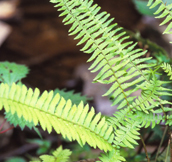
 Polystichum tripteron (Kunze) Presl Dryopteridaceae
Polystichum tripteron (Kunze) Presl Dryopteridaceae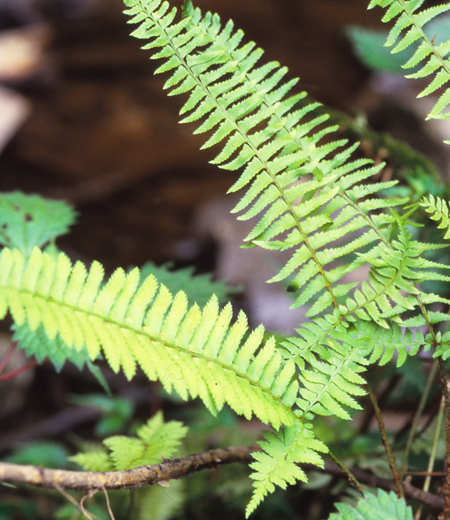 Summer green ferns (wilt in winter) or evergreen ferns that have green leaves throughout the year found in wet areas at forest edges and forests in mountains. Two pinnas at the bottom is exceptionally long creating cross-shaped, hence the Japanese name Jyumonji-sida literally meaning cross-shaped ferns. Rhizomes and petioles have brown scales (scale-like shape parts found on stems and petioles in ferns) densely placed but sprout are edible after removing these scales and marinated or tempura. Petioles are about 15 to 35 cm long and small leaves on pinnas are hook-shaped and about 3 to 5 cm. The entire plant becomes up to about 60 cm. Have sorus randomly placed near leaf axils. Spore cases are protected with indusium and have irregular toothed margins (edges of leaves are like a teeth of saw). Spore ripe earlier than other ferns.
Summer green ferns (wilt in winter) or evergreen ferns that have green leaves throughout the year found in wet areas at forest edges and forests in mountains. Two pinnas at the bottom is exceptionally long creating cross-shaped, hence the Japanese name Jyumonji-sida literally meaning cross-shaped ferns. Rhizomes and petioles have brown scales (scale-like shape parts found on stems and petioles in ferns) densely placed but sprout are edible after removing these scales and marinated or tempura. Petioles are about 15 to 35 cm long and small leaves on pinnas are hook-shaped and about 3 to 5 cm. The entire plant becomes up to about 60 cm. Have sorus randomly placed near leaf axils. Spore cases are protected with indusium and have irregular toothed margins (edges of leaves are like a teeth of saw). Spore ripe earlier than other ferns.
●Season January to about December
●Length of Leaves about 30 to 60 cm
●Place Ura-Takao -
Woodwardia orientalis Blechnaceae
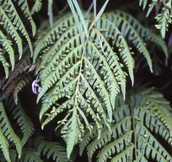
 Woodwardia orientalis Blechnaceae
Woodwardia orientalis Blechnaceae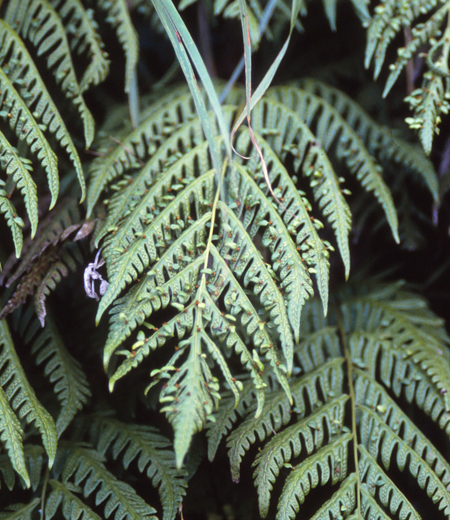 Evergreen ferns that have green leaves throughout the year found in sunny cliffs. Grow with spore and by dropping asextual buds (an organ sprout apart from the plant), hence the Japanese name Komochi-sida literally meaning child-holding ferns. Asextual buds grow in between sorus (spore case to store spores) and grow small leaves from the surface of leaves from summer and autumn. And sprouts drop on the ground and grow new fern. Petioles are about 30 to 60 cm long and the entire plant become about 30 cm to 2 m and dropping. Leaves are thick, hard and shiny with toothed margins (edges of leaves are like a teeth of saw). Spore cases are protected with indusium and about 2 to 5 cm sorus are placed along midribs on leaf axils.
Evergreen ferns that have green leaves throughout the year found in sunny cliffs. Grow with spore and by dropping asextual buds (an organ sprout apart from the plant), hence the Japanese name Komochi-sida literally meaning child-holding ferns. Asextual buds grow in between sorus (spore case to store spores) and grow small leaves from the surface of leaves from summer and autumn. And sprouts drop on the ground and grow new fern. Petioles are about 30 to 60 cm long and the entire plant become about 30 cm to 2 m and dropping. Leaves are thick, hard and shiny with toothed margins (edges of leaves are like a teeth of saw). Spore cases are protected with indusium and about 2 to 5 cm sorus are placed along midribs on leaf axils.
●Season January to about December
●Length of Leaves about 30 cm to 2 m
●Place Ura-Takao -
Crepidomanes minutum Hymenophyllaceae
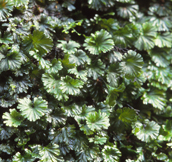
 Crepidomanes minutum Hymenophyllaceae
Crepidomanes minutum Hymenophyllaceae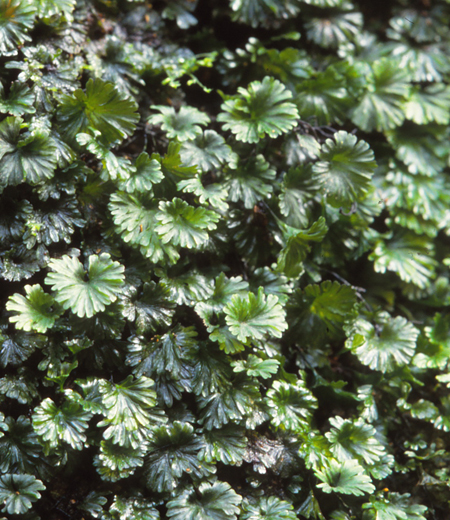 Evergreen ferns that have green leaves throughout the year found in wet areas in forests in mountains. The Japanese name includes the word moss but this is a small-sized fern and grows on rocks or trees in clusters. Rhizomes are thin like wires and have black hairs densely placed. Grow by trailing along the surface like a floor mat. Leaves are round fan-shaped or heart-shaped and about 1 to 2 cm in diameter. Edges are irregularly lobed like a palm. The Japanese name Uchiwa-goke paper fan moss was named because the shape of leaves is like paper fans. Petioles are like threads and 1 cm long. Texture of leaf is thin like transparent. Bell-shaped indusium grows on the petioles from the edges of leaves and has sorus holds spores.
Evergreen ferns that have green leaves throughout the year found in wet areas in forests in mountains. The Japanese name includes the word moss but this is a small-sized fern and grows on rocks or trees in clusters. Rhizomes are thin like wires and have black hairs densely placed. Grow by trailing along the surface like a floor mat. Leaves are round fan-shaped or heart-shaped and about 1 to 2 cm in diameter. Edges are irregularly lobed like a palm. The Japanese name Uchiwa-goke paper fan moss was named because the shape of leaves is like paper fans. Petioles are like threads and 1 cm long. Texture of leaf is thin like transparent. Bell-shaped indusium grows on the petioles from the edges of leaves and has sorus holds spores.
●Season January to about December
●Height about 1 to 2 cm
●Place Trail 6 -
Lepisorus thunbergianus Polypodiaceae
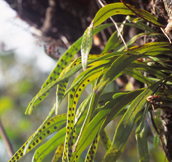
 Lepisorus thunbergianus Polypodiaceae
Lepisorus thunbergianus Polypodiaceae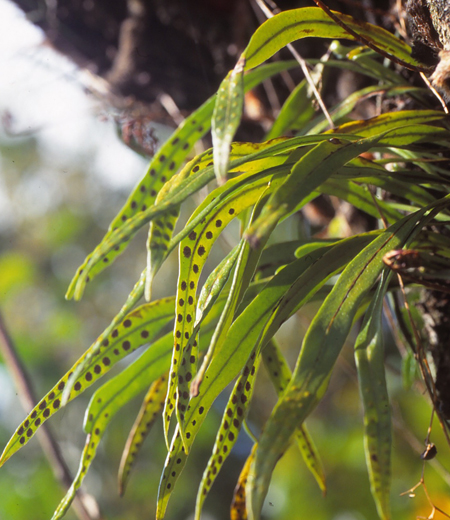 Evergreen ferns that have green leaves throughout the year found on rock fences near residential areas and old trees with moss. It was often found under thatched roofs or spaces under eaves, hence the Japanese name Nosiki-nobu hiding under eaves. Rhizomes are short and have scales (scale-like shape parts found on stems and petioles in ferns). Grow horizontally by growing many small roots. Leaves are like elongated like willow and about 12 to 30 cm long and grow densely from rhizomes. Leaf surface is yellow-green but lighter on the back. Texture is thick like leather and bear cold weather. Left and right side of leaves curled backwards when dry, and wait until leaves receive some moisture. Sorus (spore sac that store spores) is about 3 mm in diameter and placed in two lines on the upper parts of the back of leaves.
Evergreen ferns that have green leaves throughout the year found on rock fences near residential areas and old trees with moss. It was often found under thatched roofs or spaces under eaves, hence the Japanese name Nosiki-nobu hiding under eaves. Rhizomes are short and have scales (scale-like shape parts found on stems and petioles in ferns). Grow horizontally by growing many small roots. Leaves are like elongated like willow and about 12 to 30 cm long and grow densely from rhizomes. Leaf surface is yellow-green but lighter on the back. Texture is thick like leather and bear cold weather. Left and right side of leaves curled backwards when dry, and wait until leaves receive some moisture. Sorus (spore sac that store spores) is about 3 mm in diameter and placed in two lines on the upper parts of the back of leaves.
●Season January to about December
●Height about 10 to 30 cm
●Place Trail 1, Oku-Takao -
Lemmaphyllum microphyllum Polypodiaceae
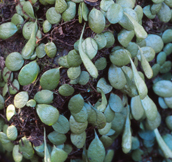
 Lemmaphyllum microphyllum Polypodiaceae
Lemmaphyllum microphyllum Polypodiaceae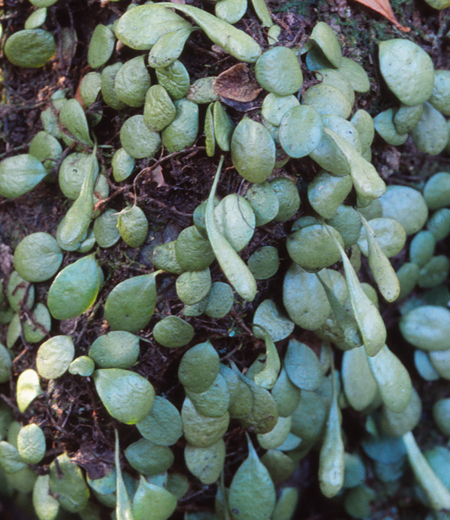 Evergreen ferns that have green leaves throughout the year found in mountains. Prefer wet areas including on trees or rocks. Rhizomes are thin and grow horizontally and have trophophyll (leaves for photonic synthesis) and some spore leaves (leaves with spores). Trophophyll is about 1 to 2 cm in diameter round to oval shaped and petioles are thick and grow by adjacent plants. Leaves are moistened, thick, shiny and bearable in dry environment. The Japanese name Mame-zuta literally meaning bean –shaped ferns was named because leaves are small and its round shape resembles beans. Spore leaves are about 5 to 6 cm elongated spatula-like shape grow from trophophills. Tips of leaves are curled inward and have brown sorus (spore sac that store spores) are densely placed.
Evergreen ferns that have green leaves throughout the year found in mountains. Prefer wet areas including on trees or rocks. Rhizomes are thin and grow horizontally and have trophophyll (leaves for photonic synthesis) and some spore leaves (leaves with spores). Trophophyll is about 1 to 2 cm in diameter round to oval shaped and petioles are thick and grow by adjacent plants. Leaves are moistened, thick, shiny and bearable in dry environment. The Japanese name Mame-zuta literally meaning bean –shaped ferns was named because leaves are small and its round shape resembles beans. Spore leaves are about 5 to 6 cm elongated spatula-like shape grow from trophophills. Tips of leaves are curled inward and have brown sorus (spore sac that store spores) are densely placed.
●Season January to about December
●Height about 5 to 6 cm
●Place Trail 1, Trail 6
